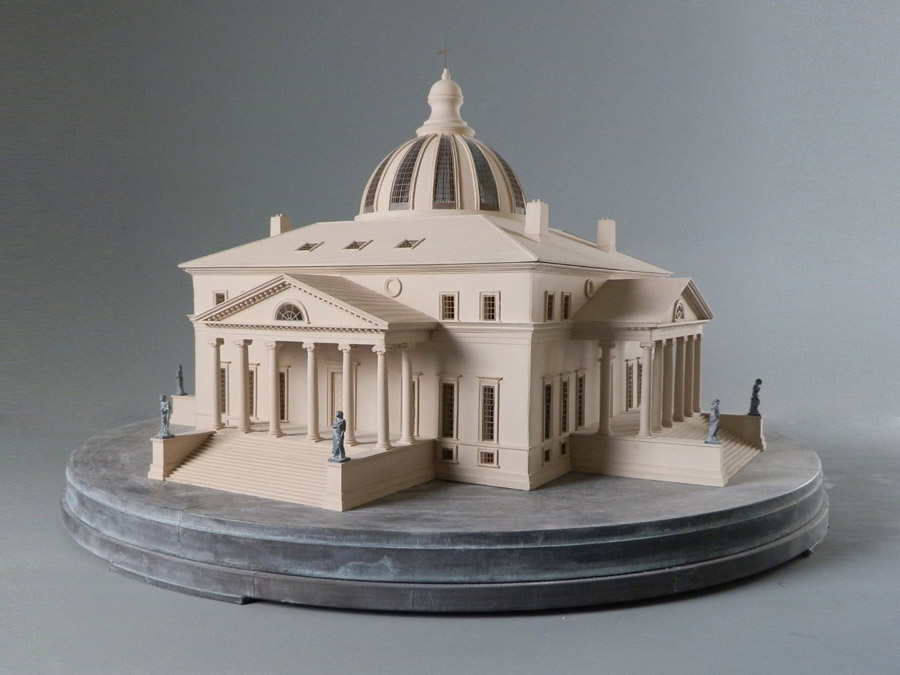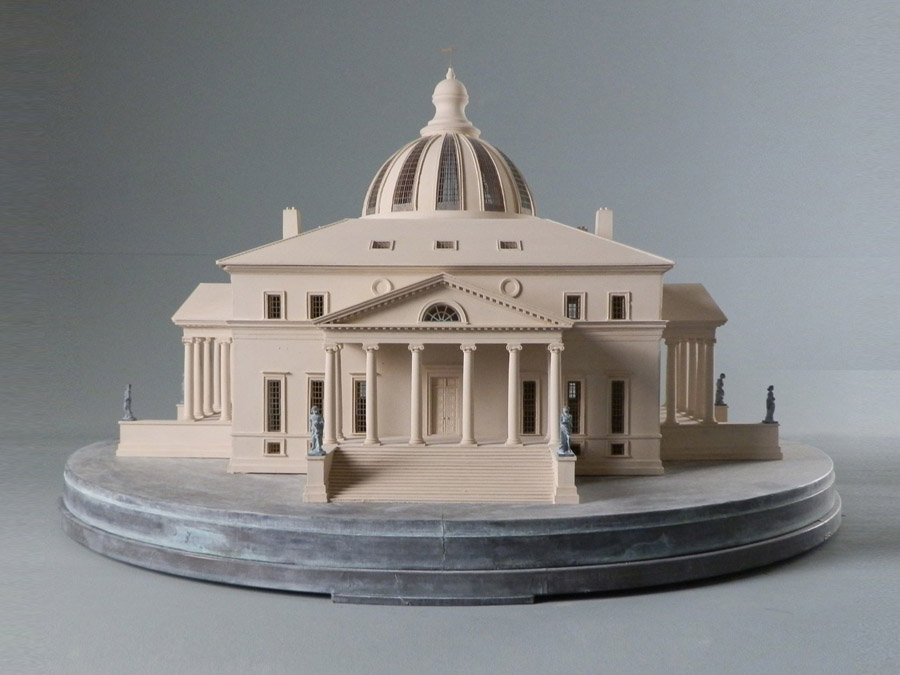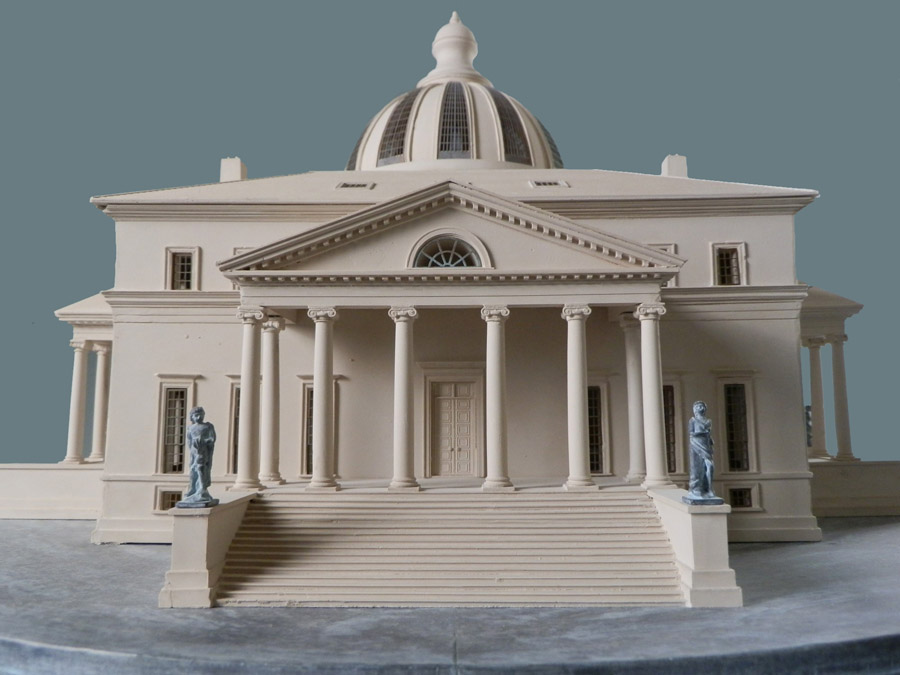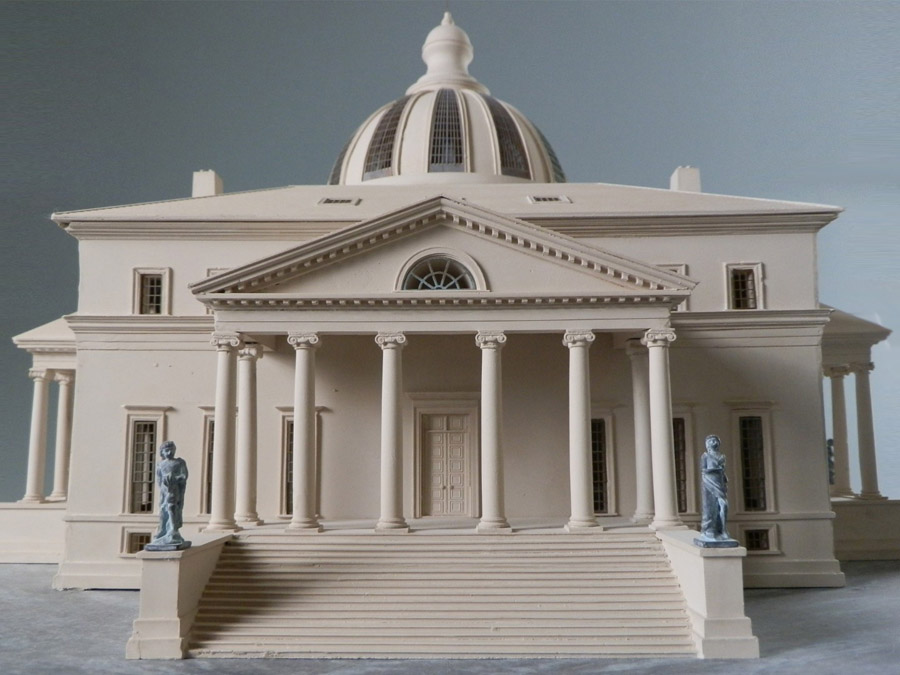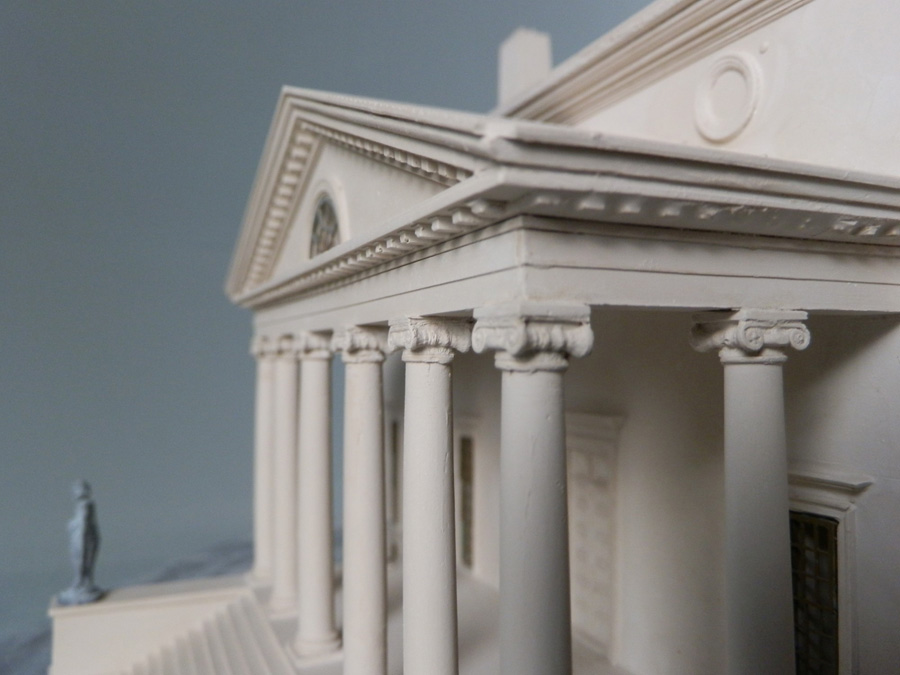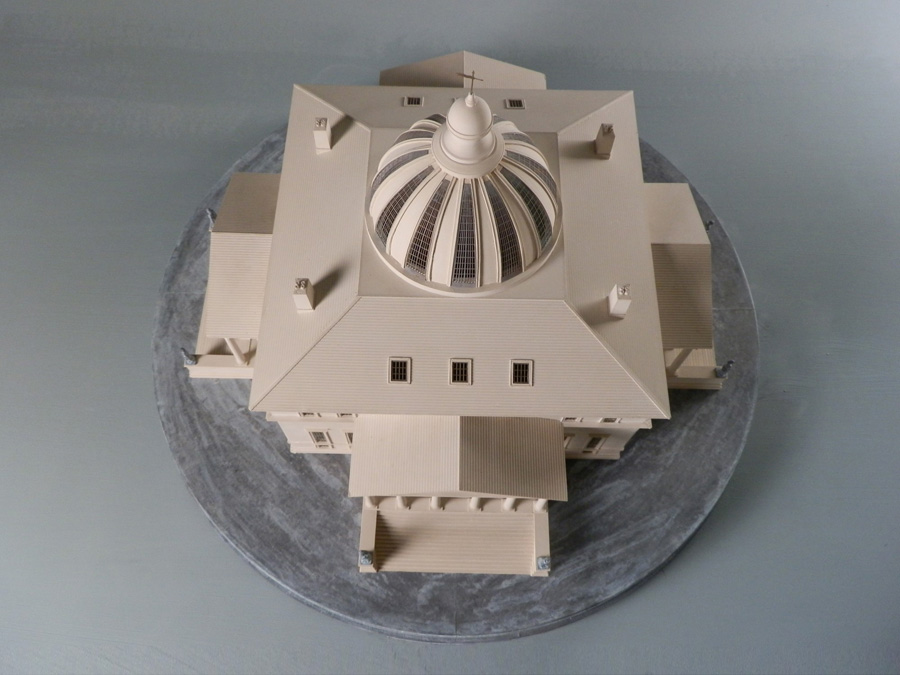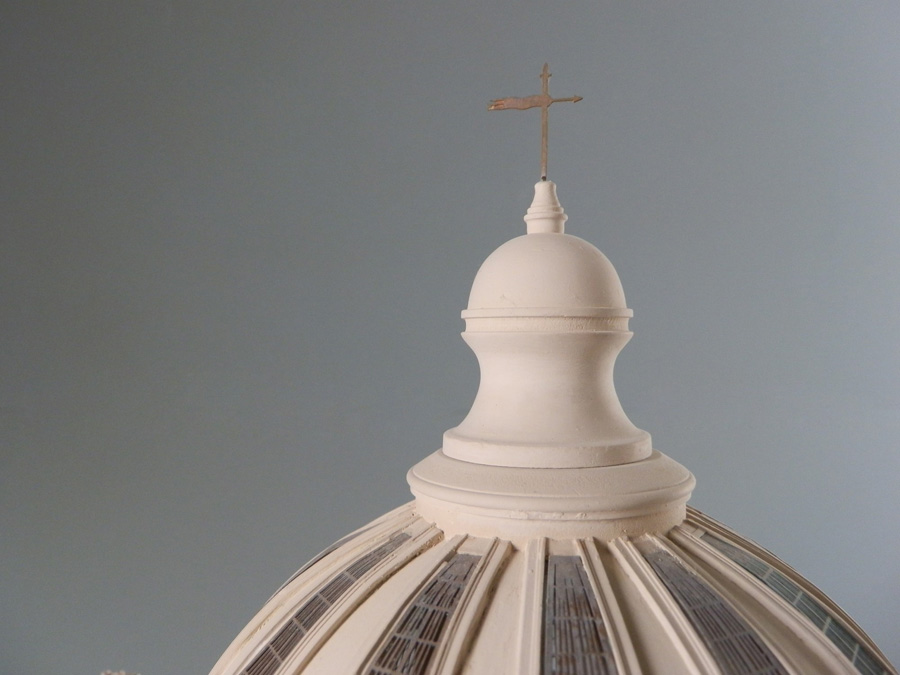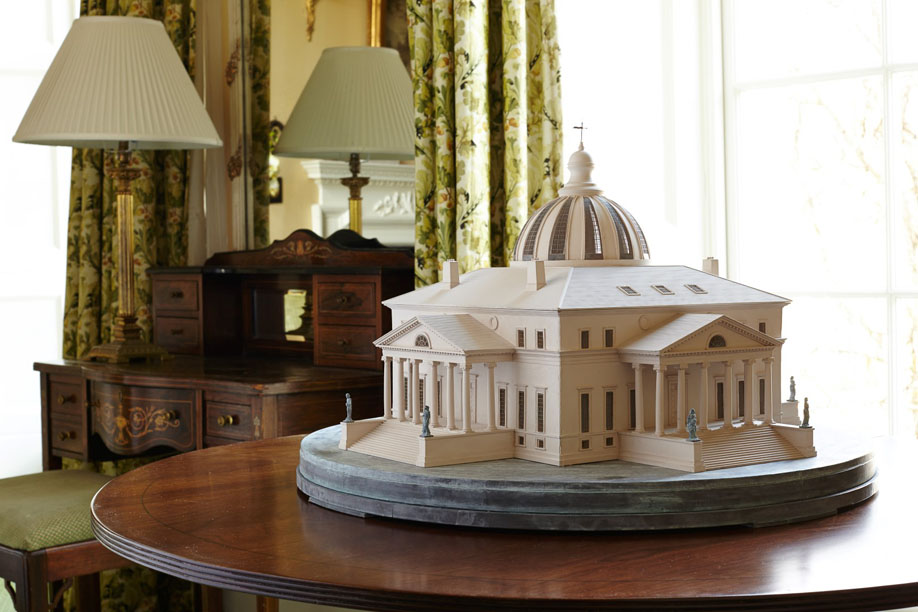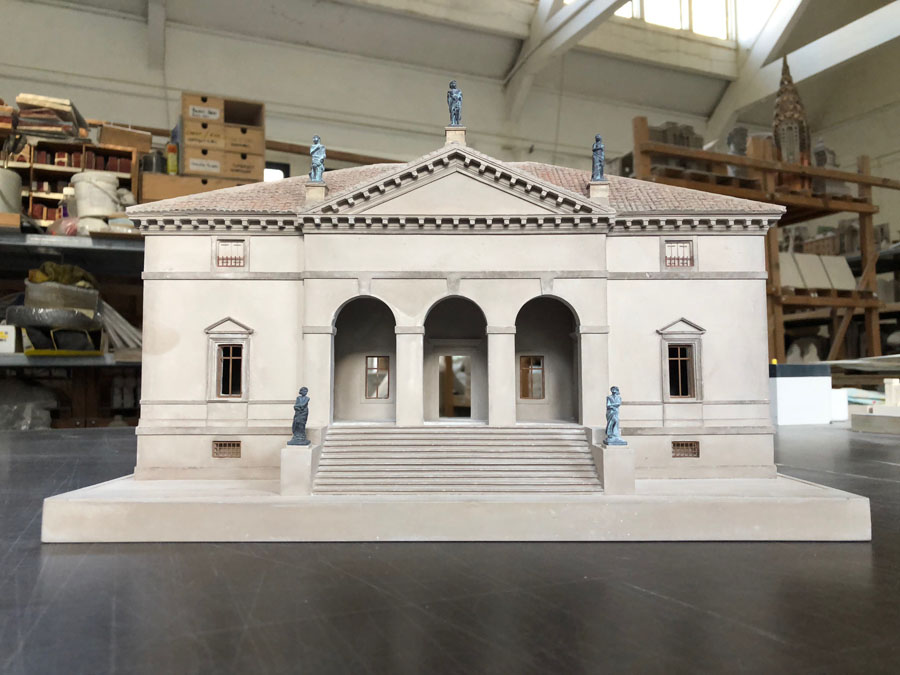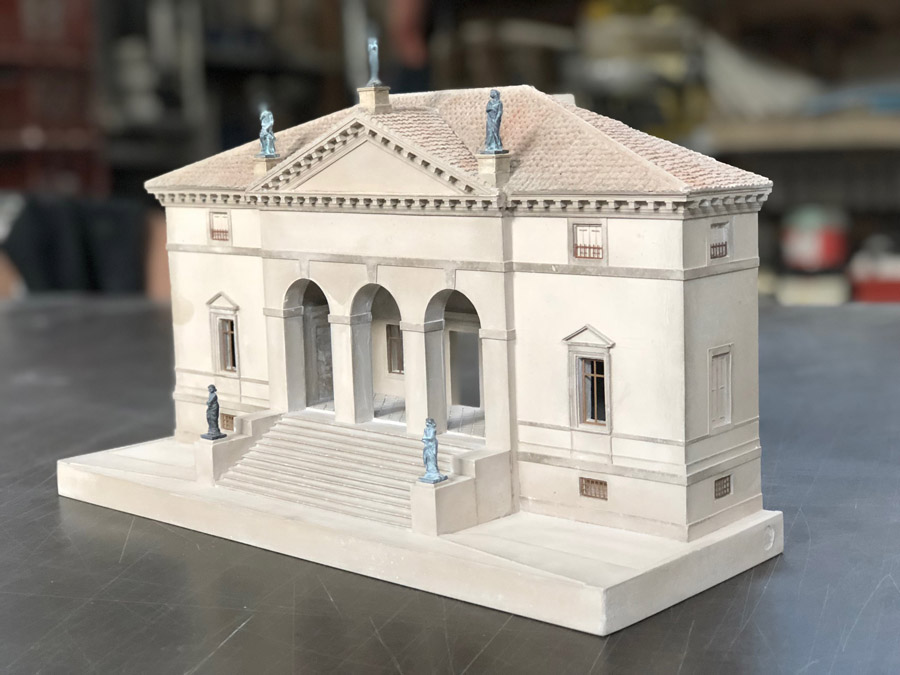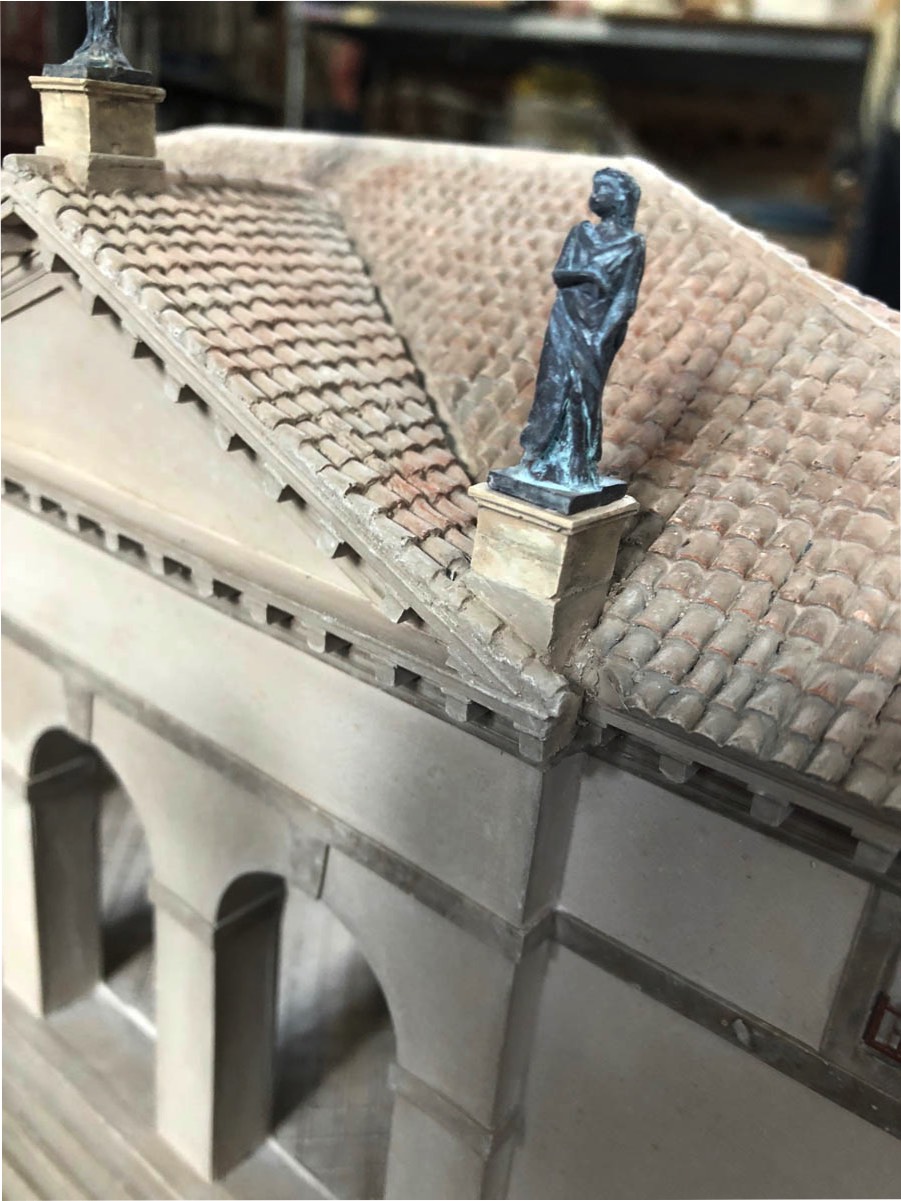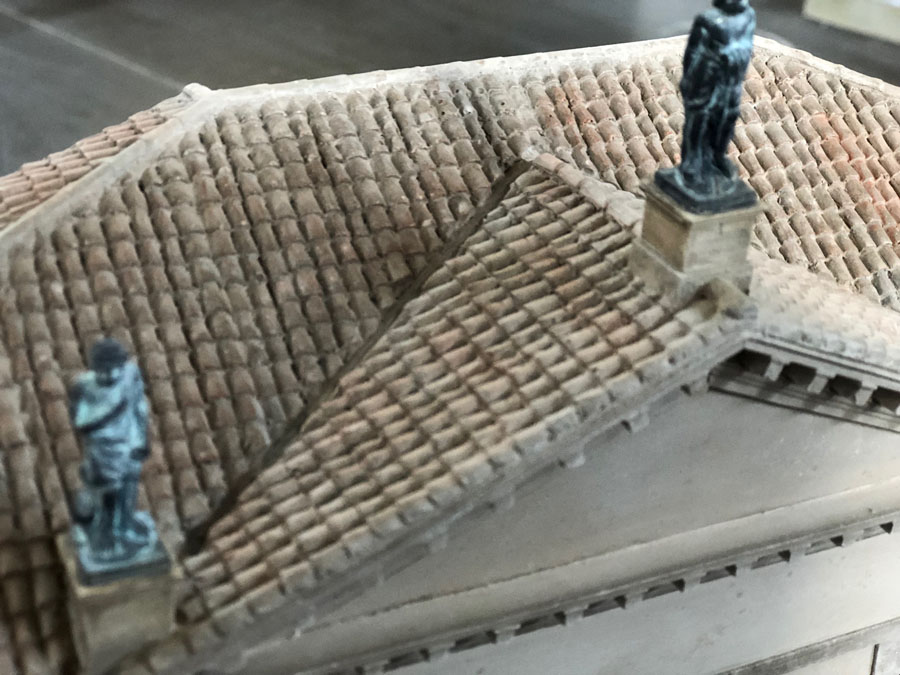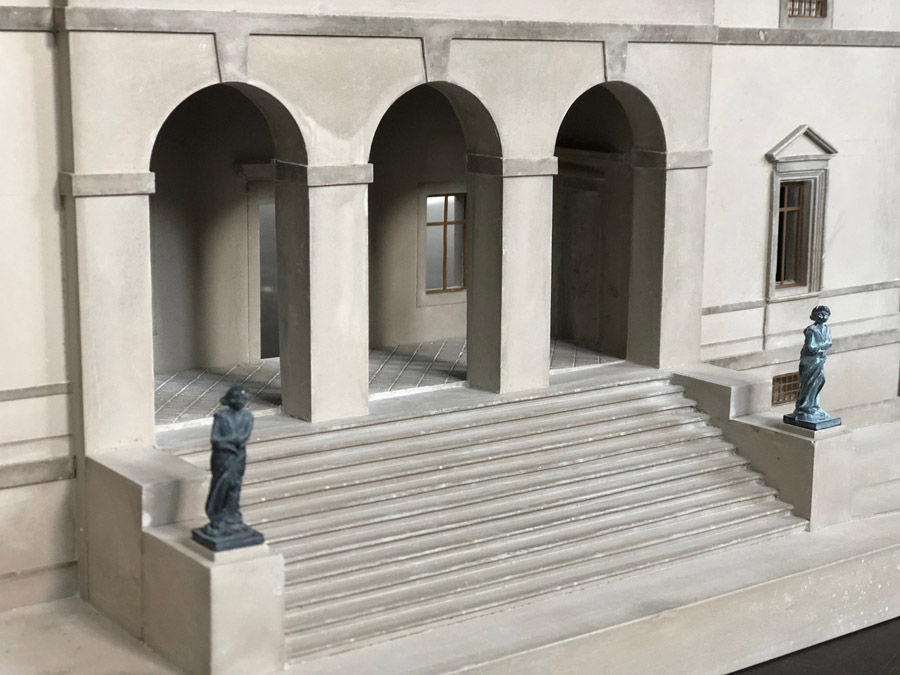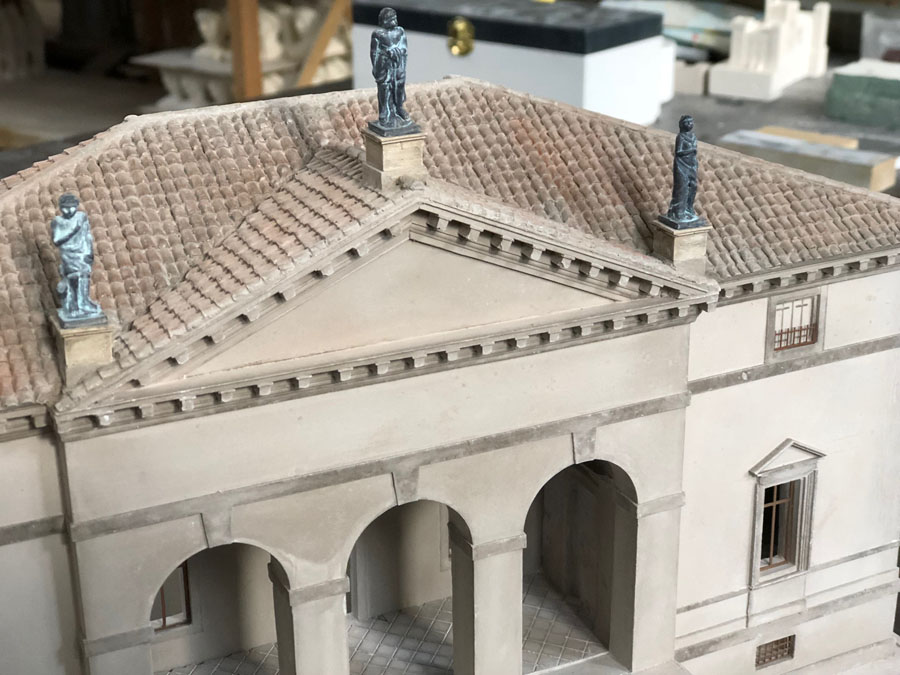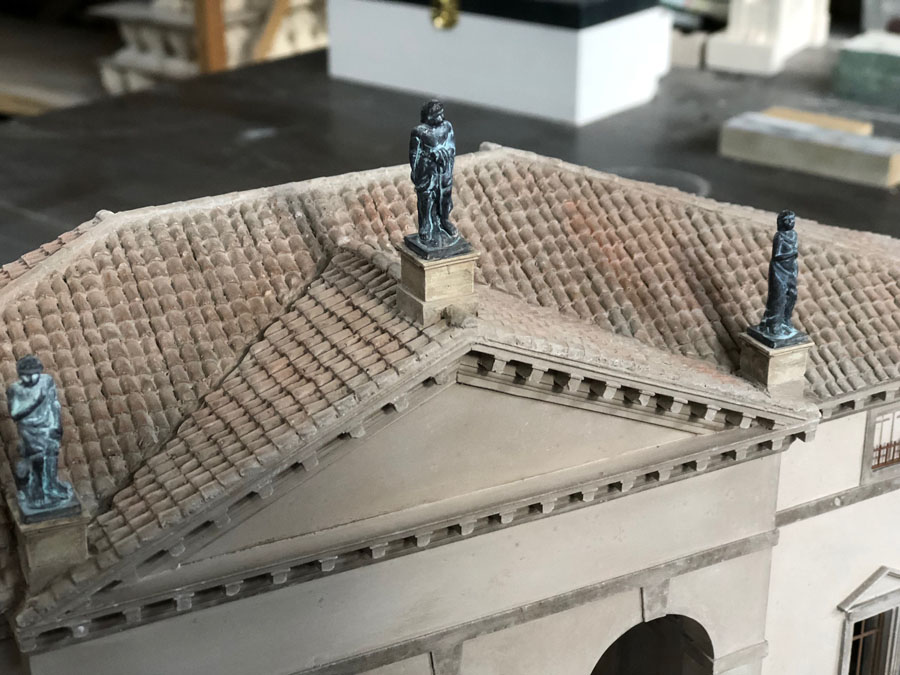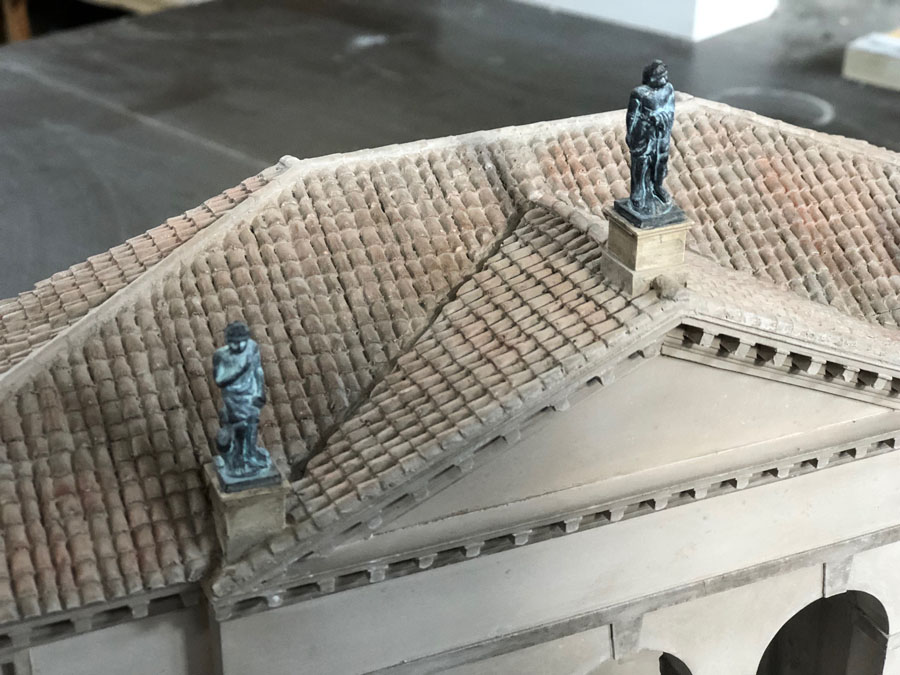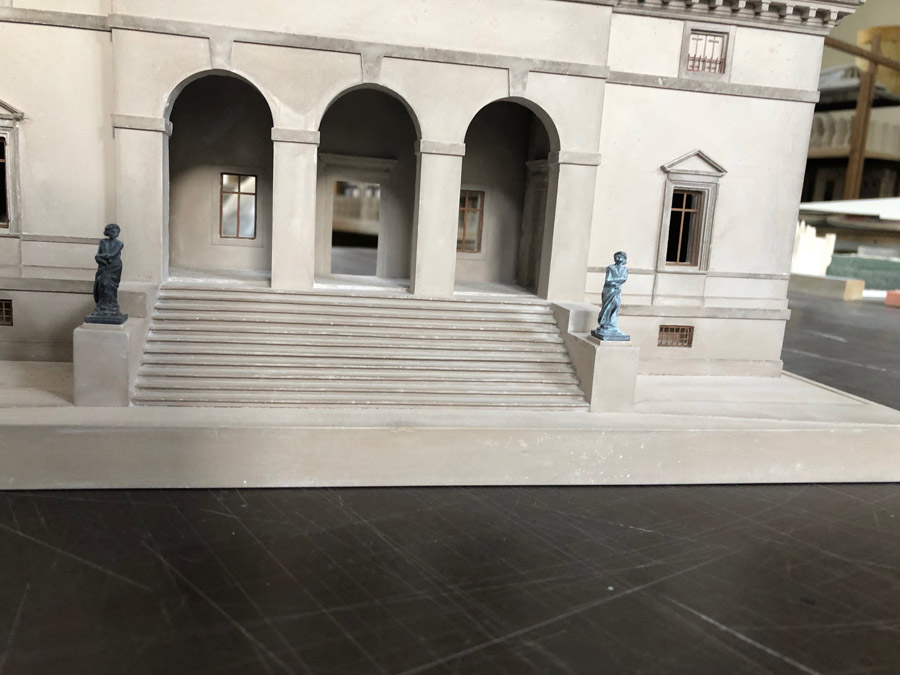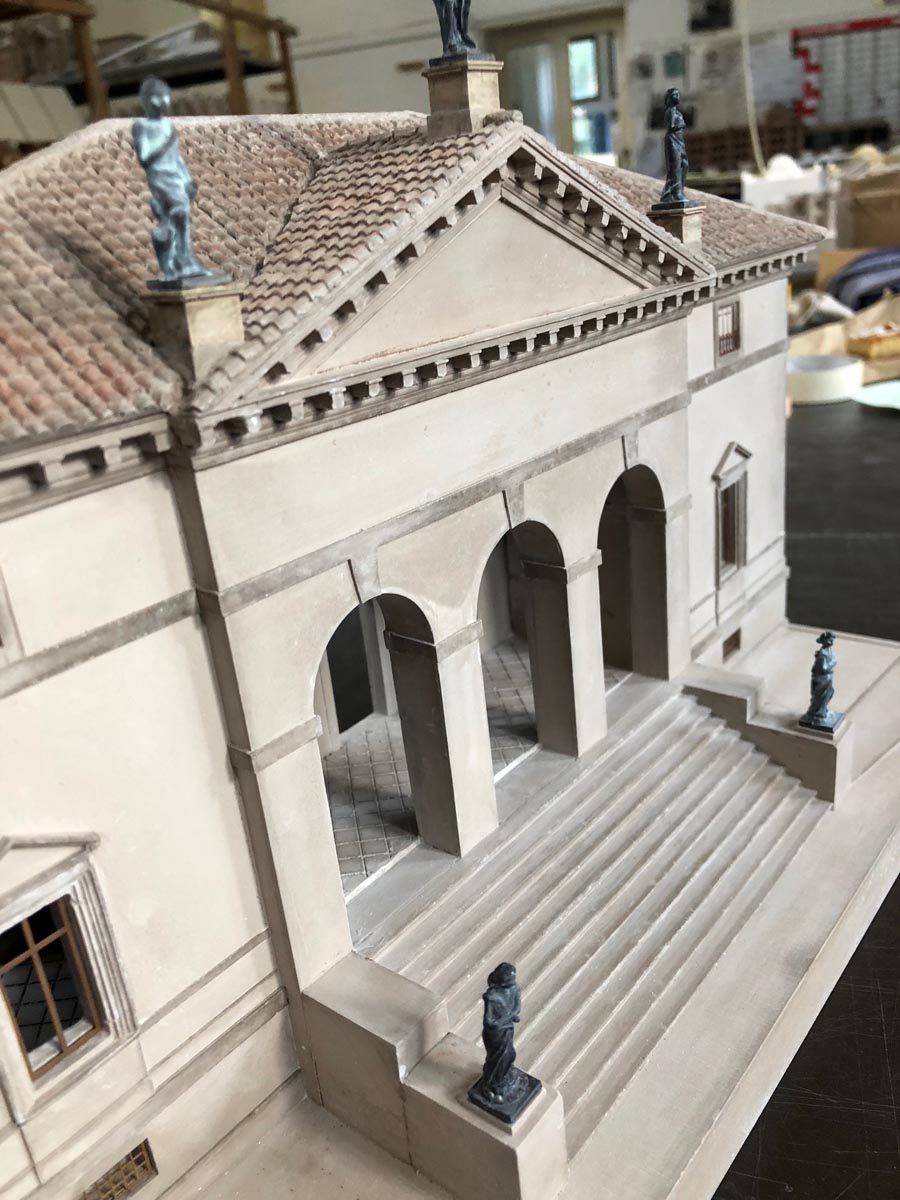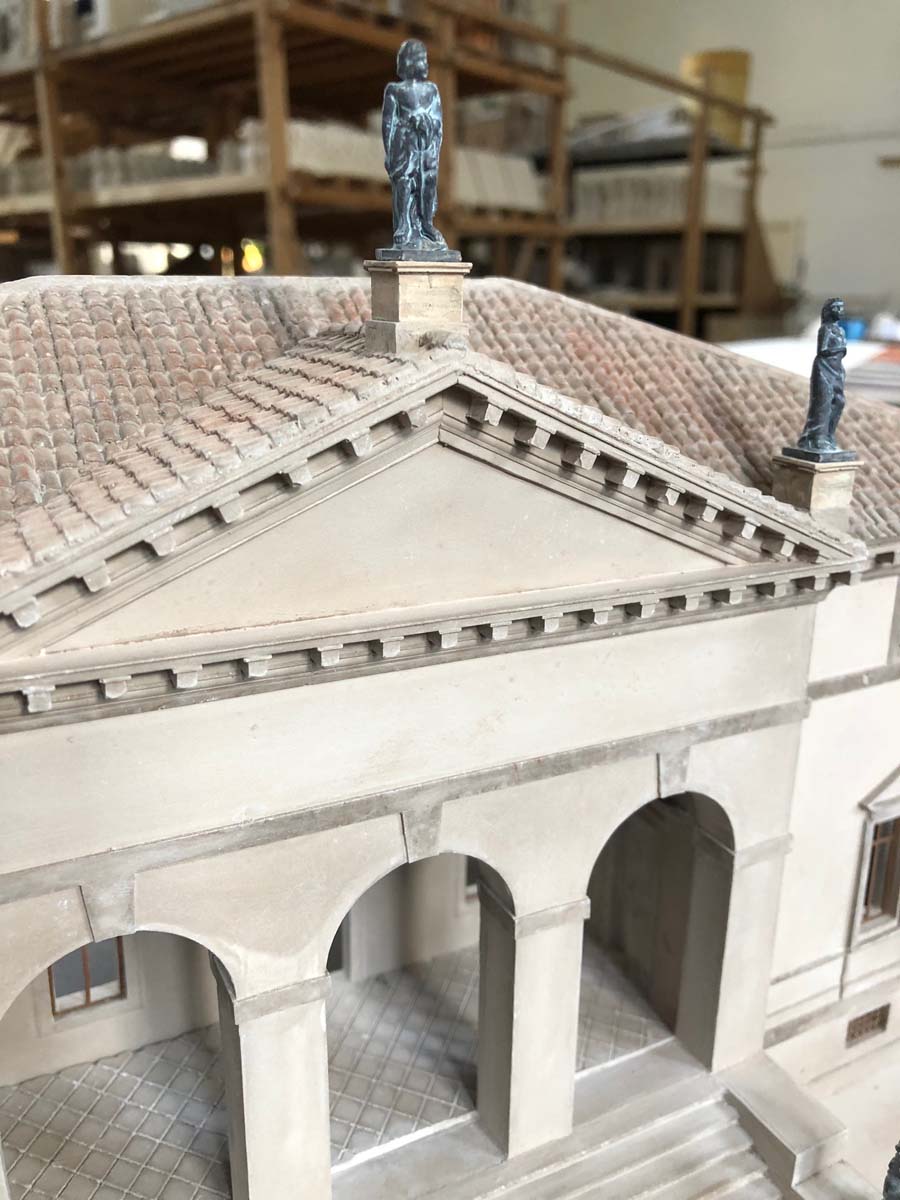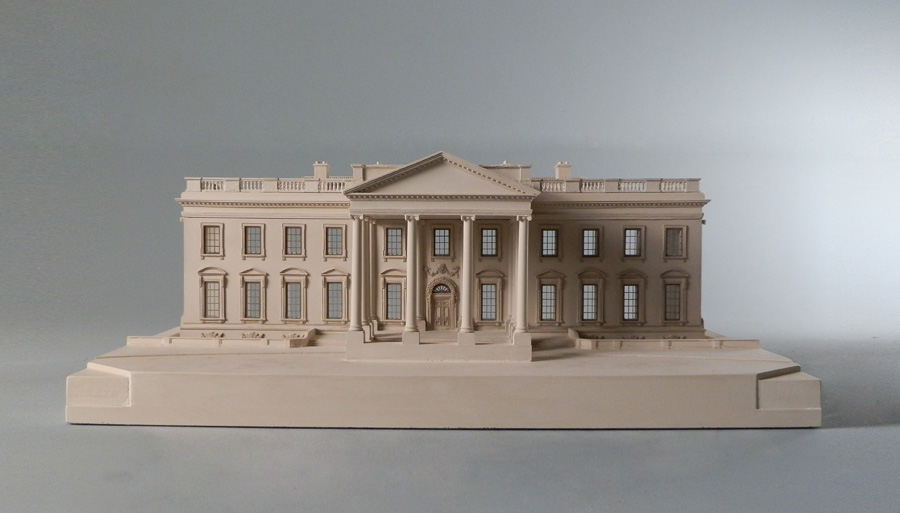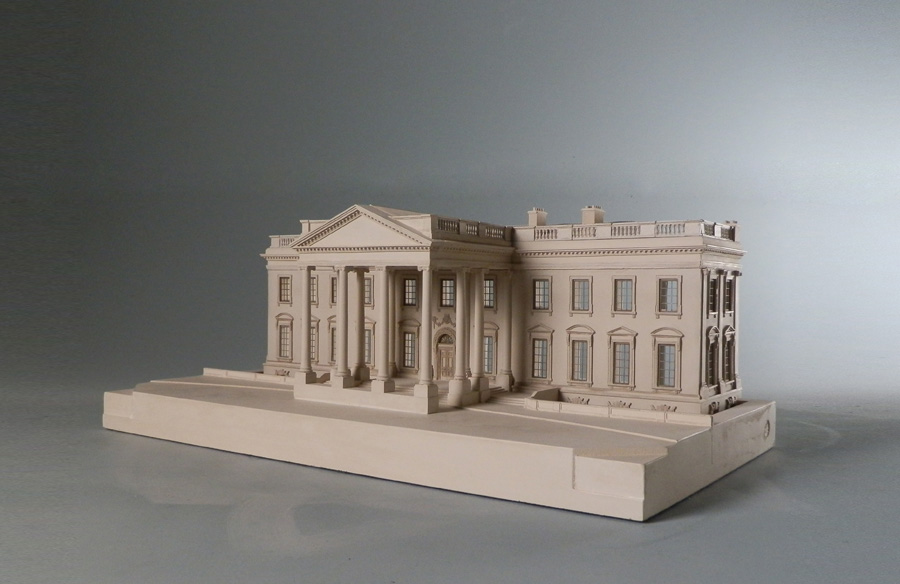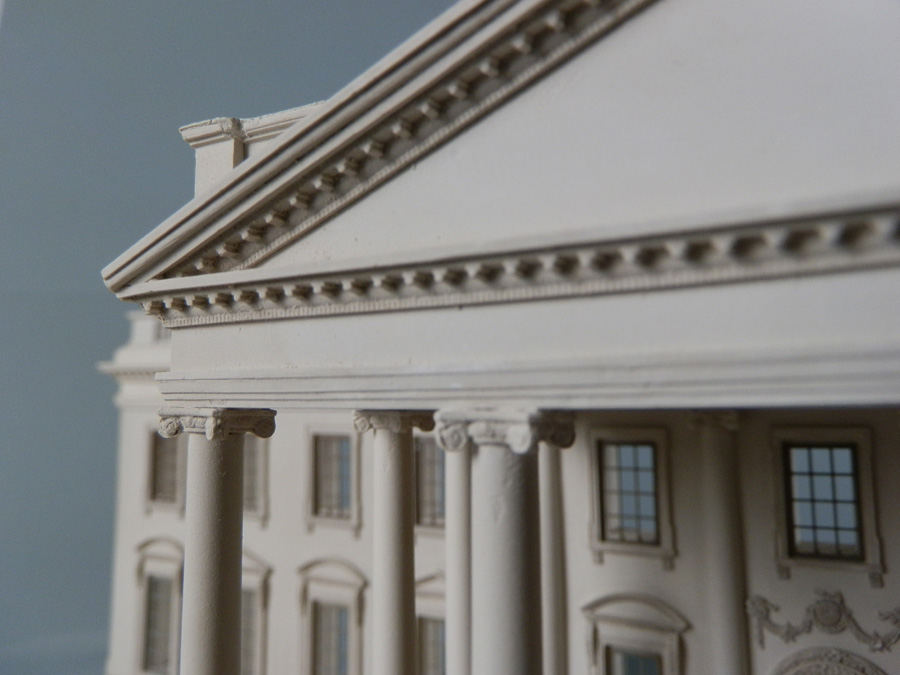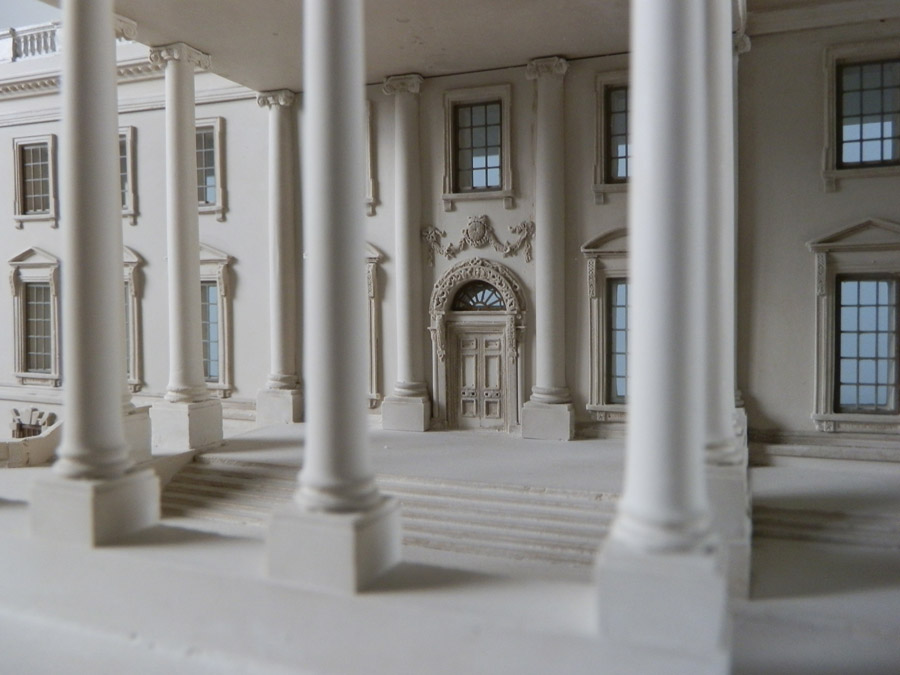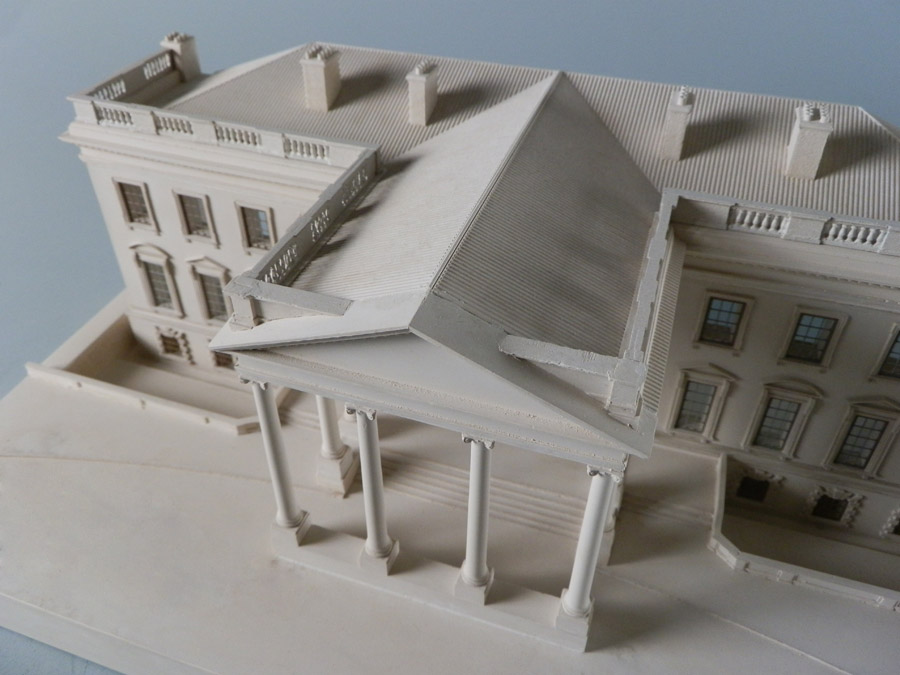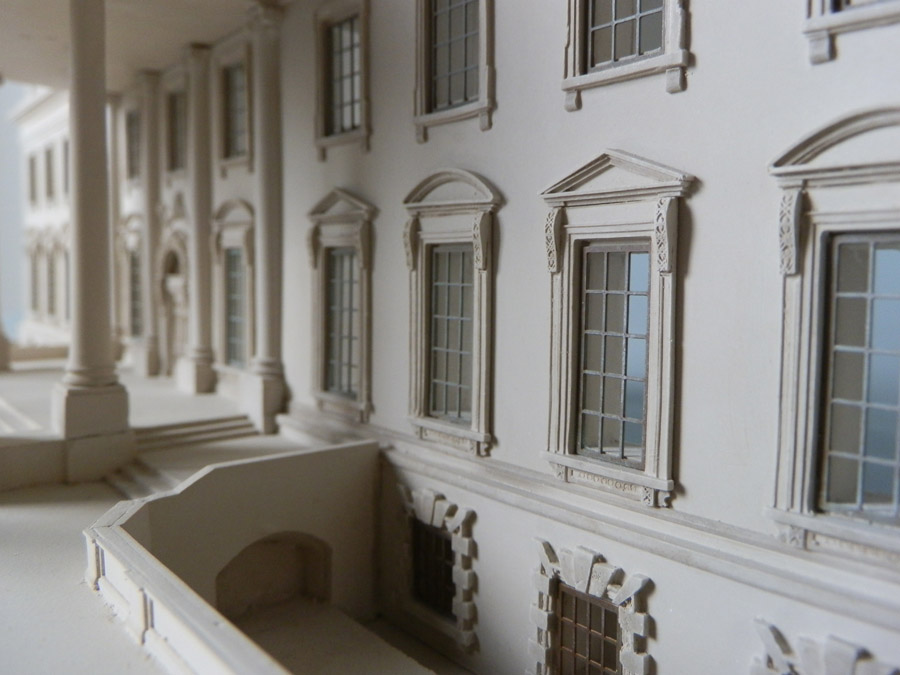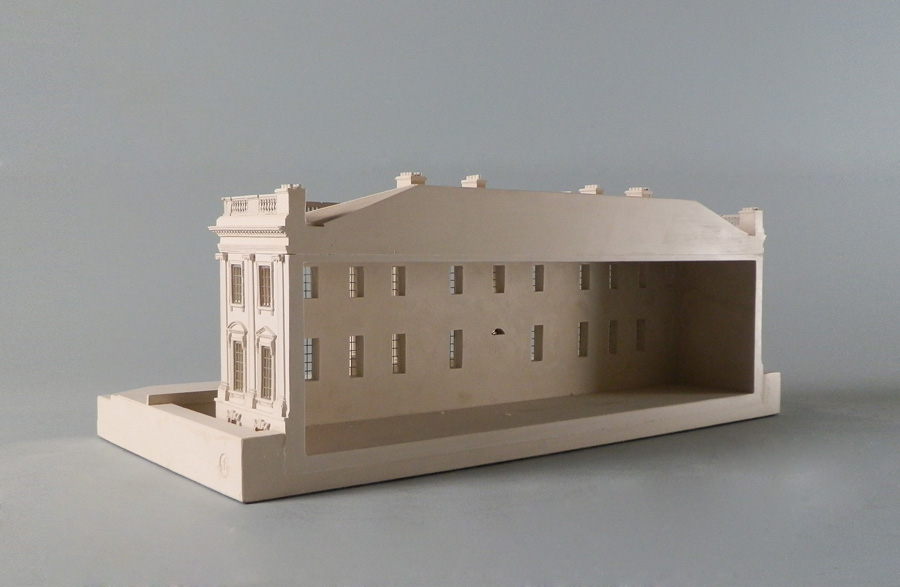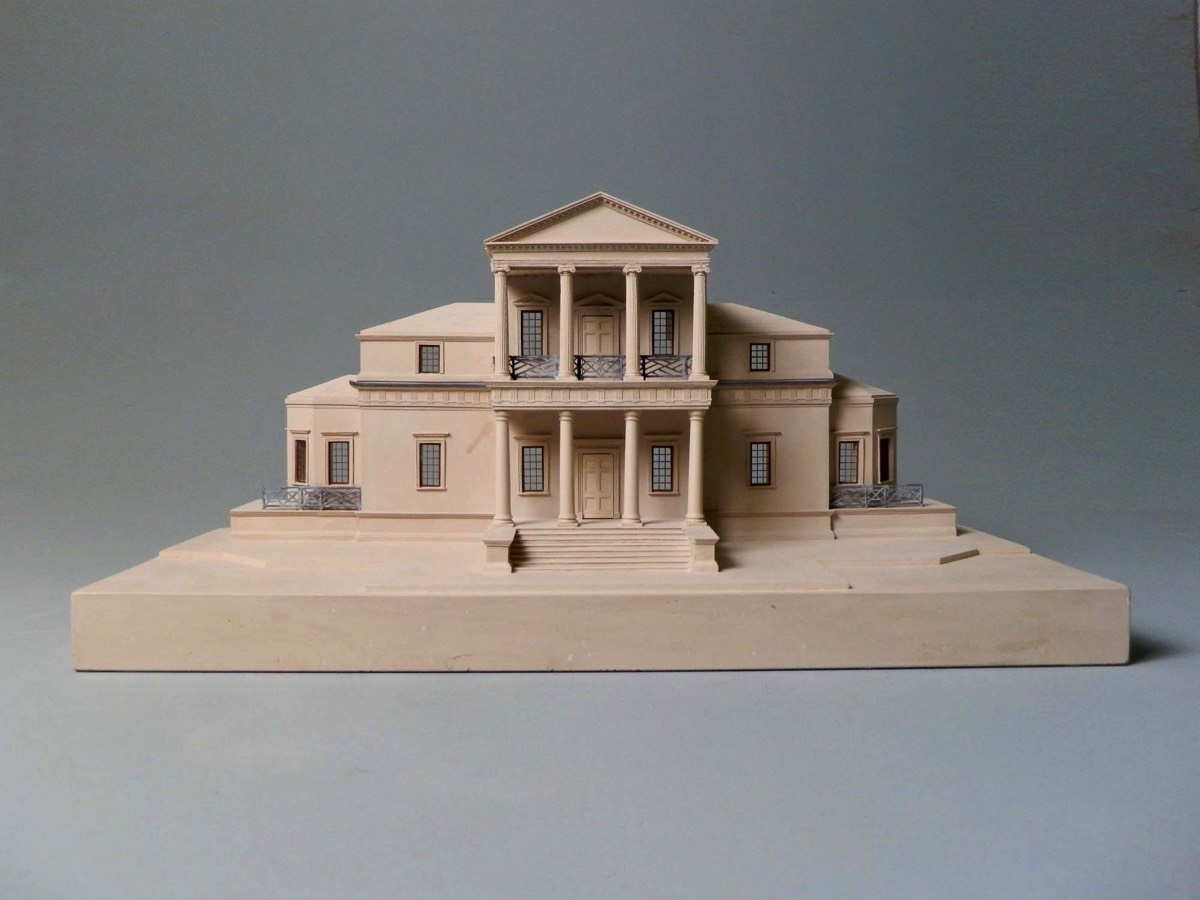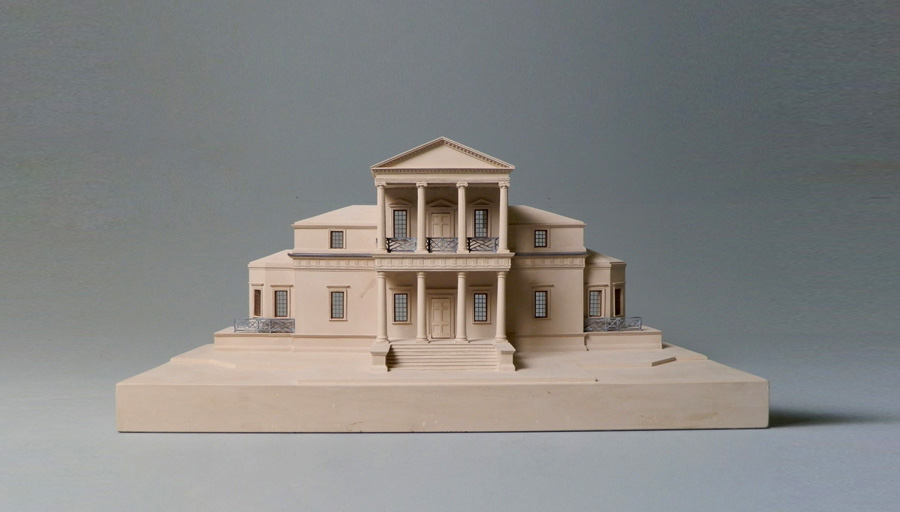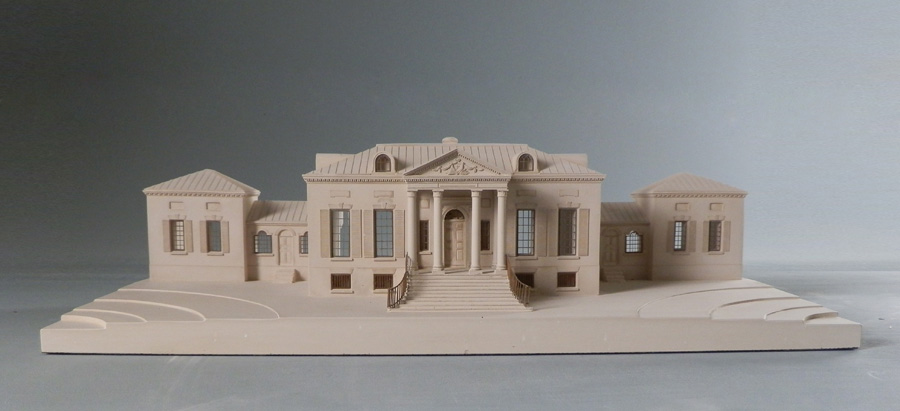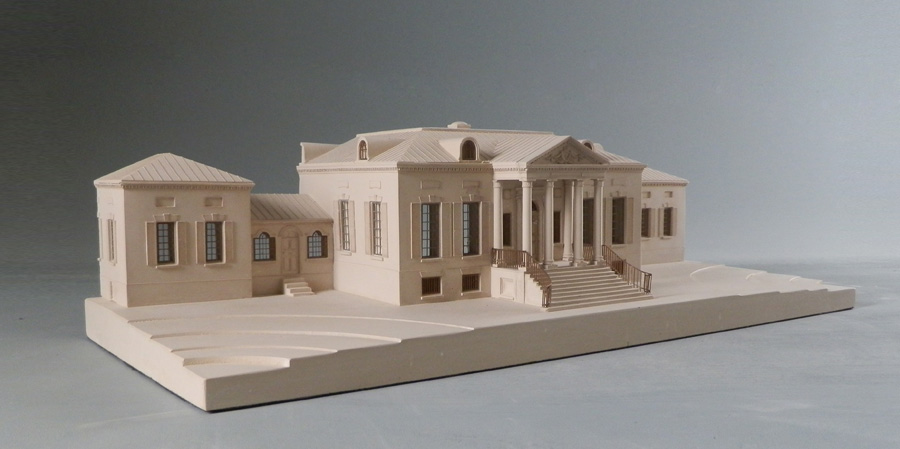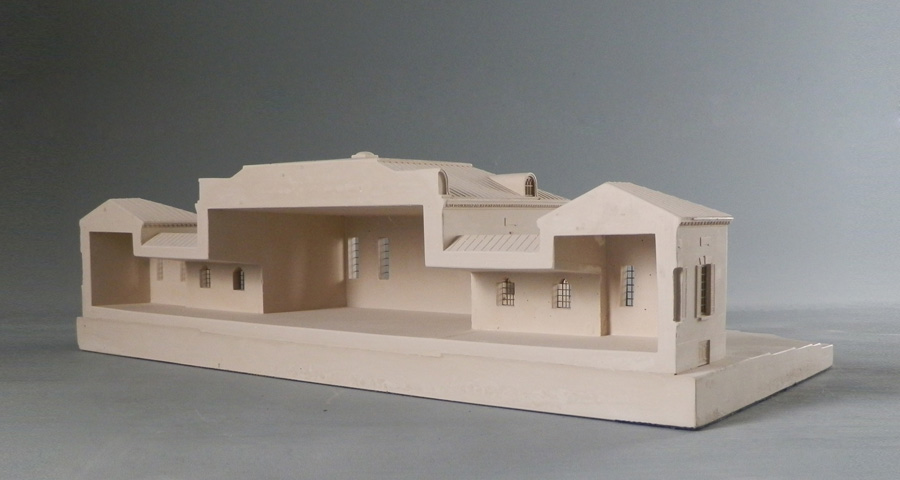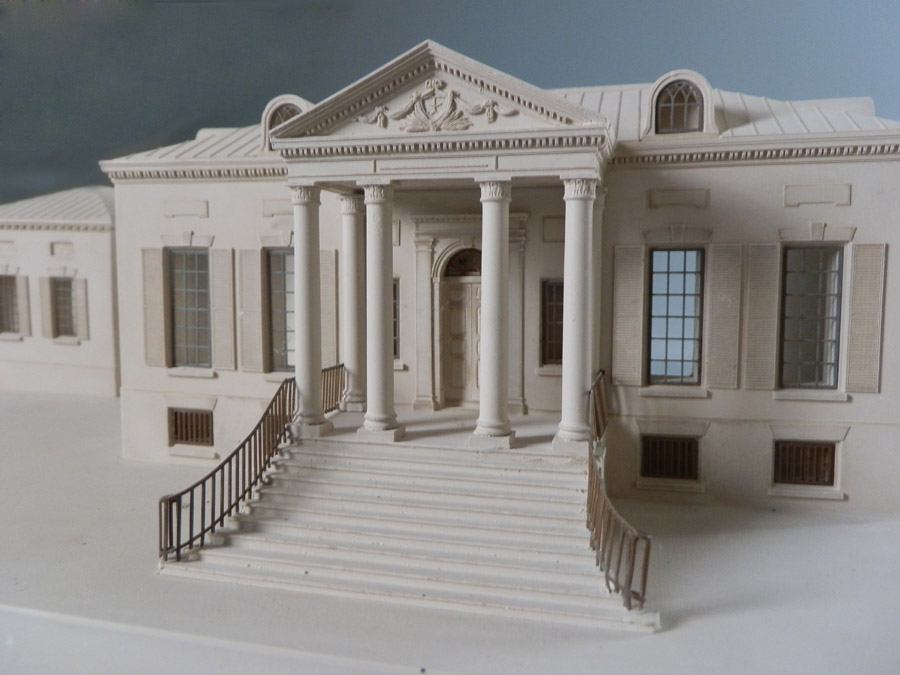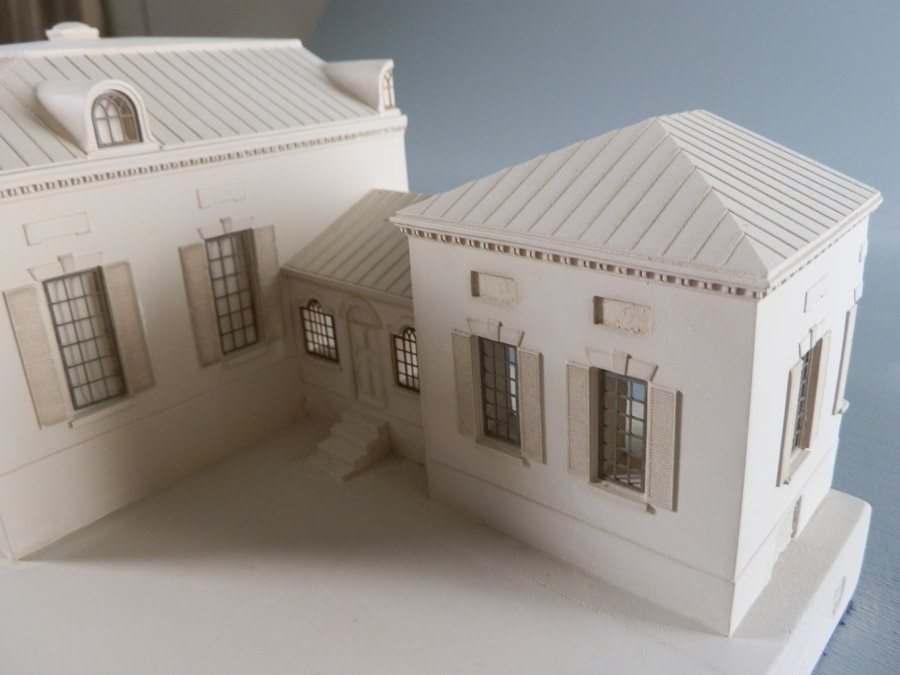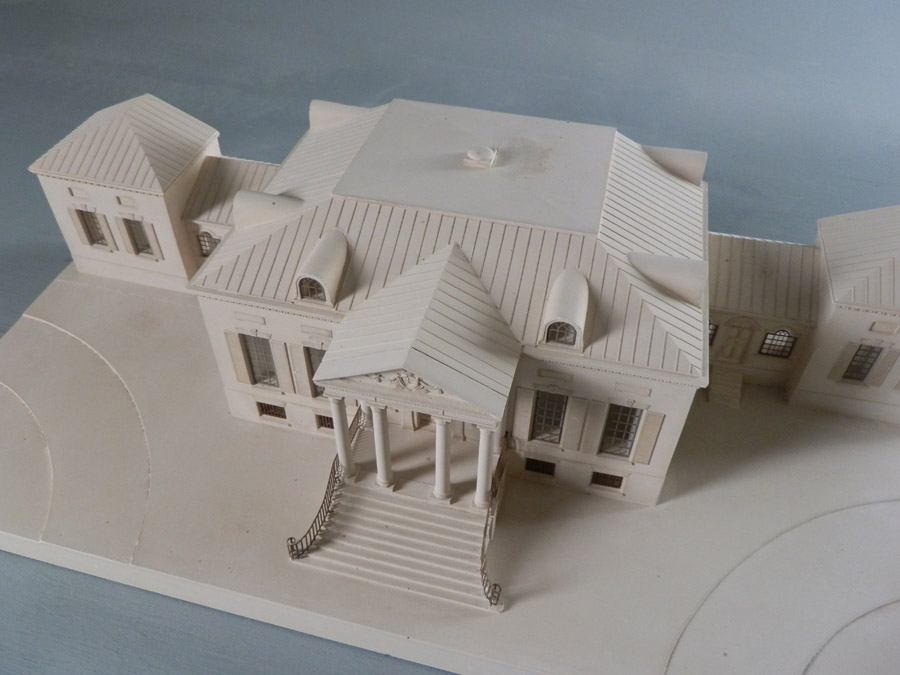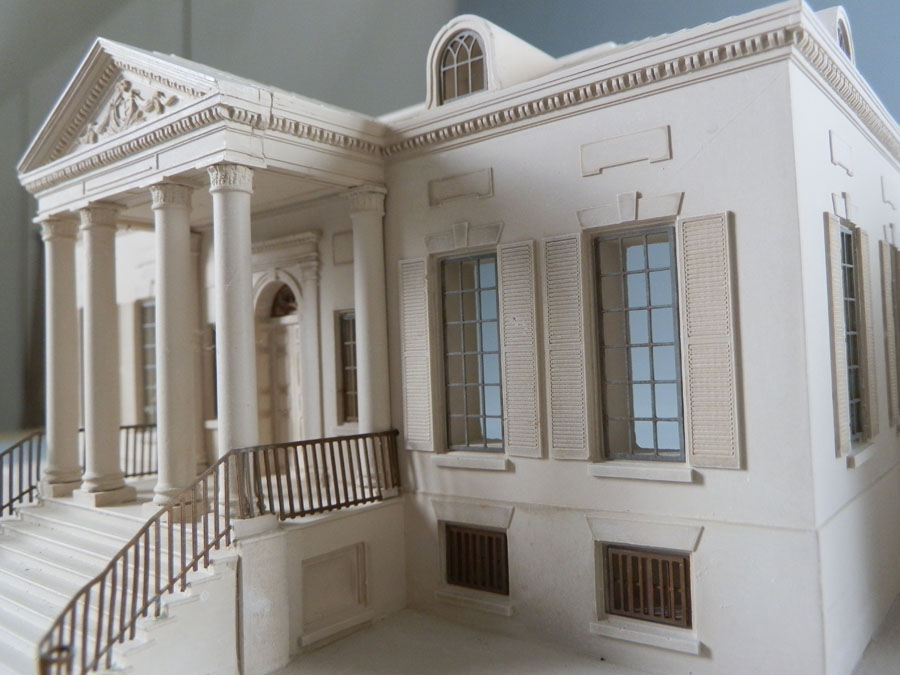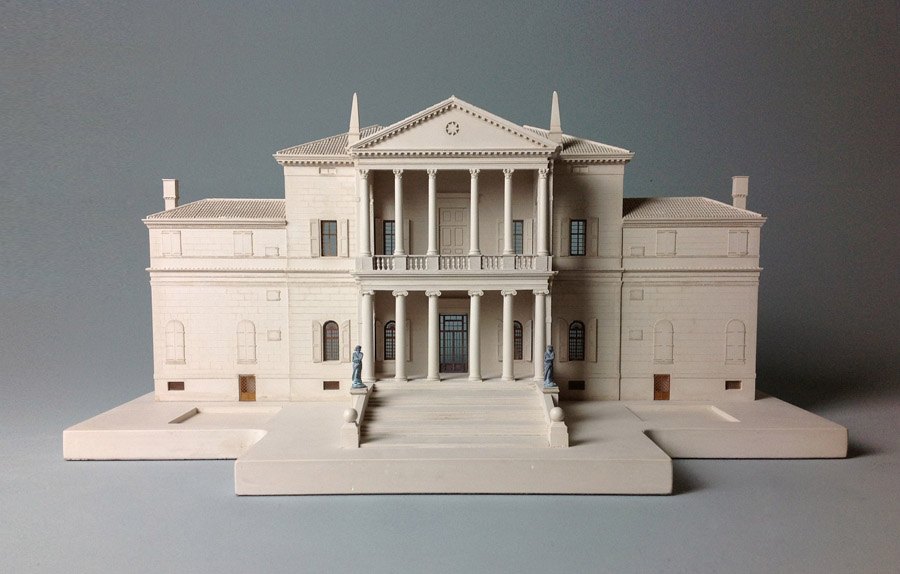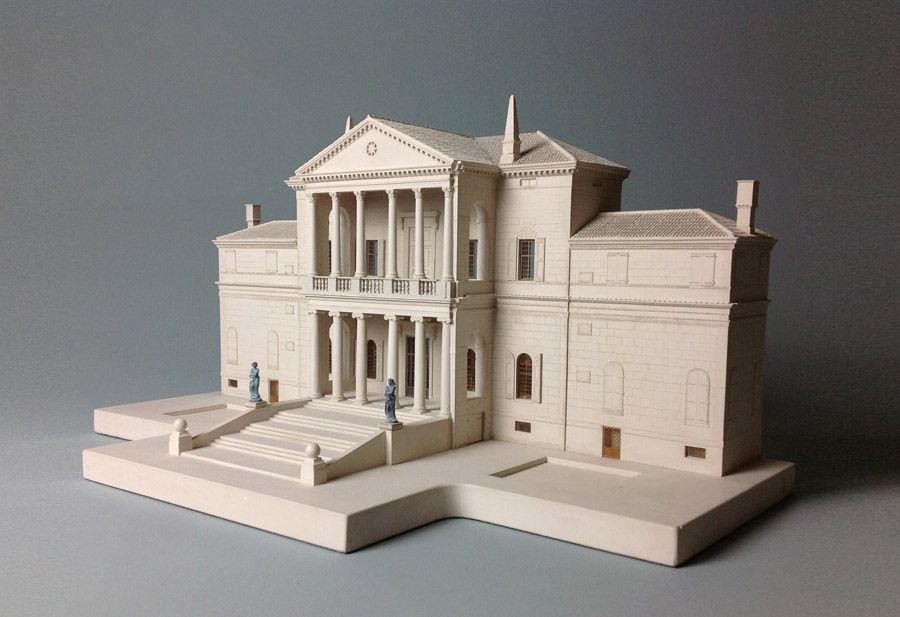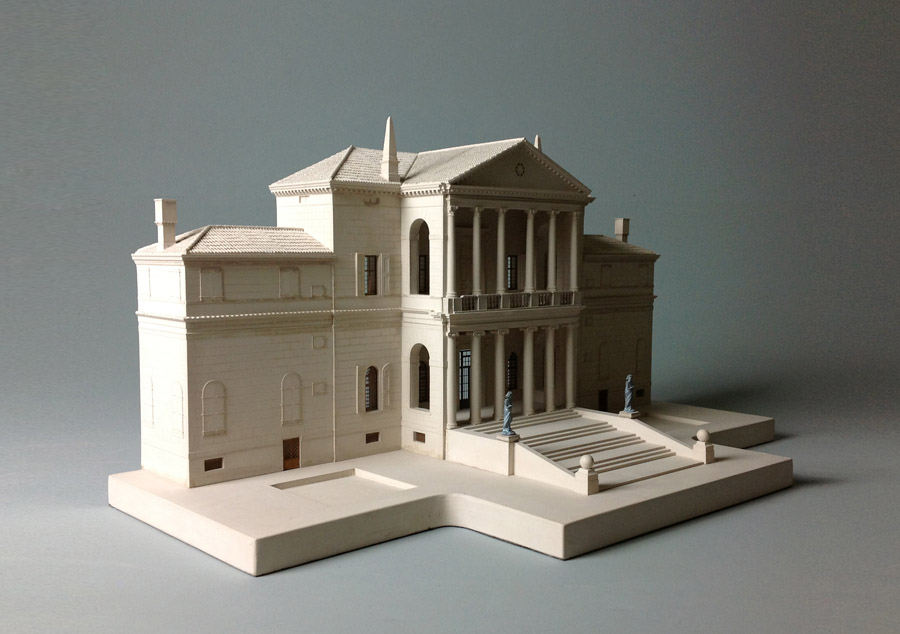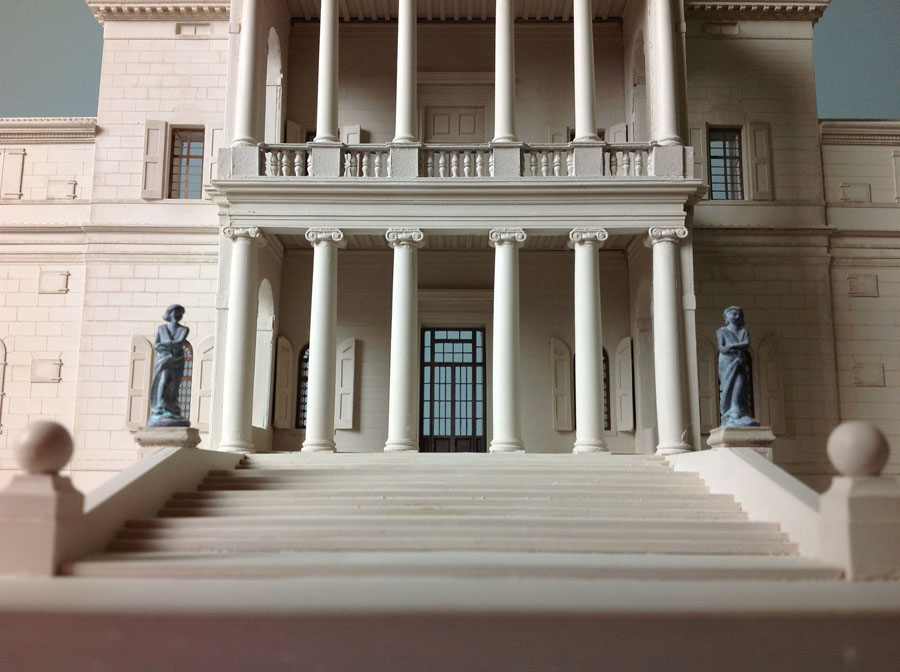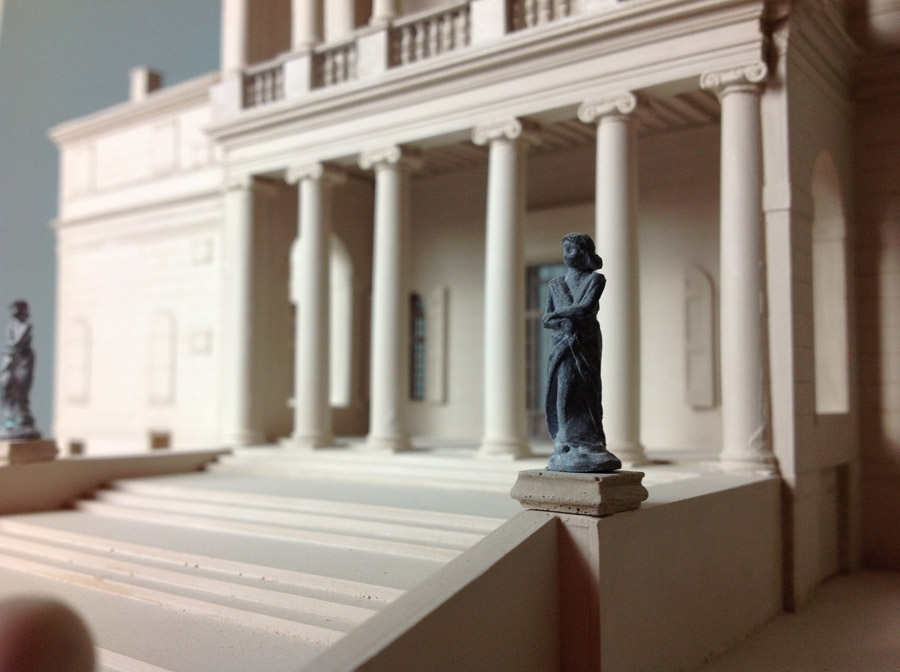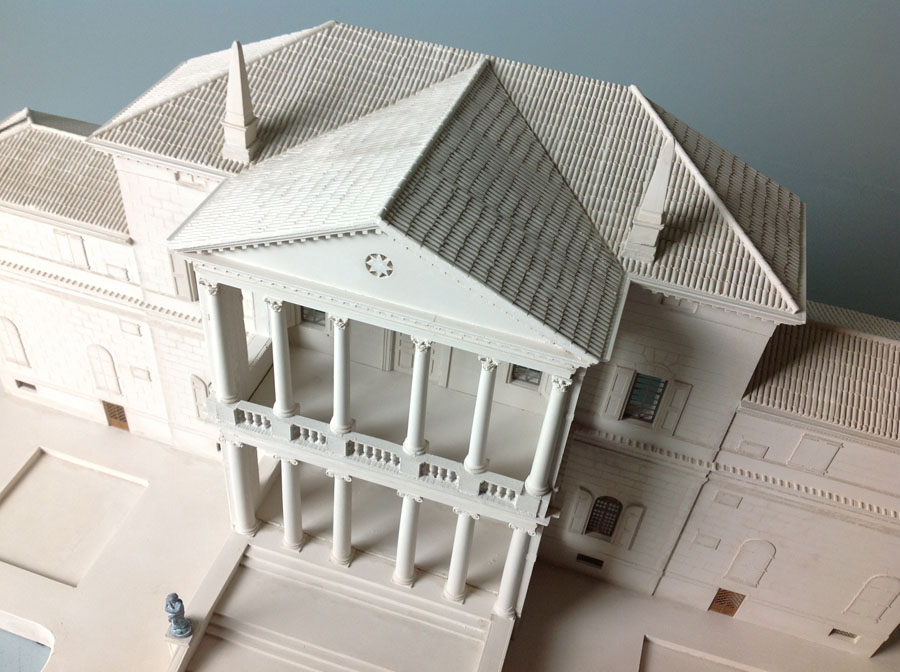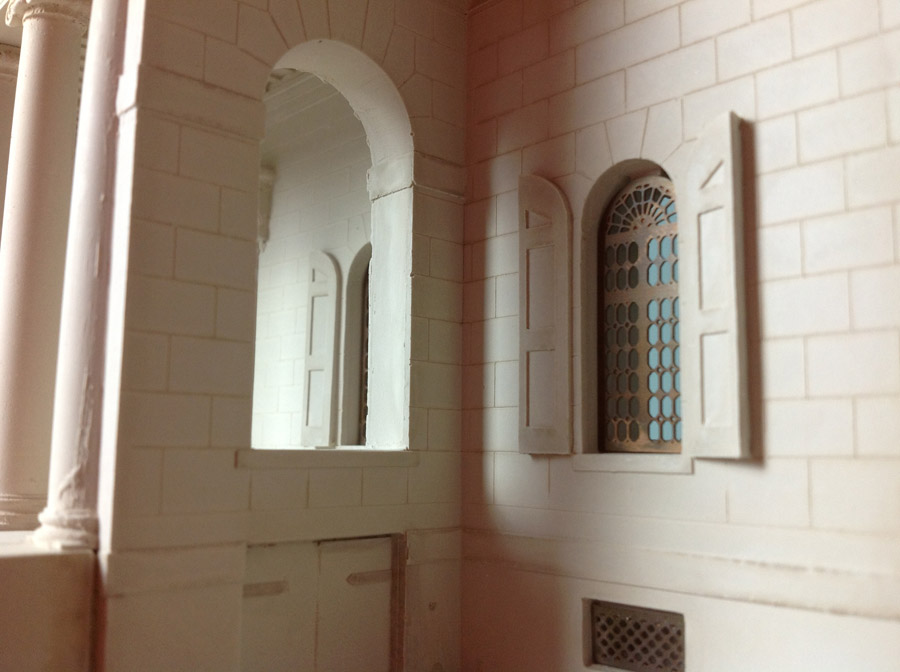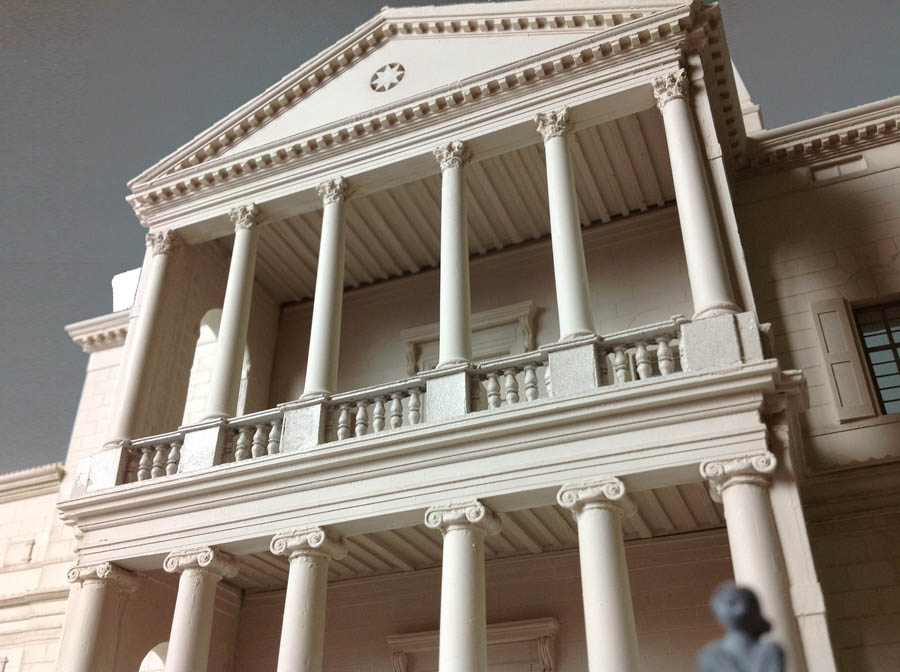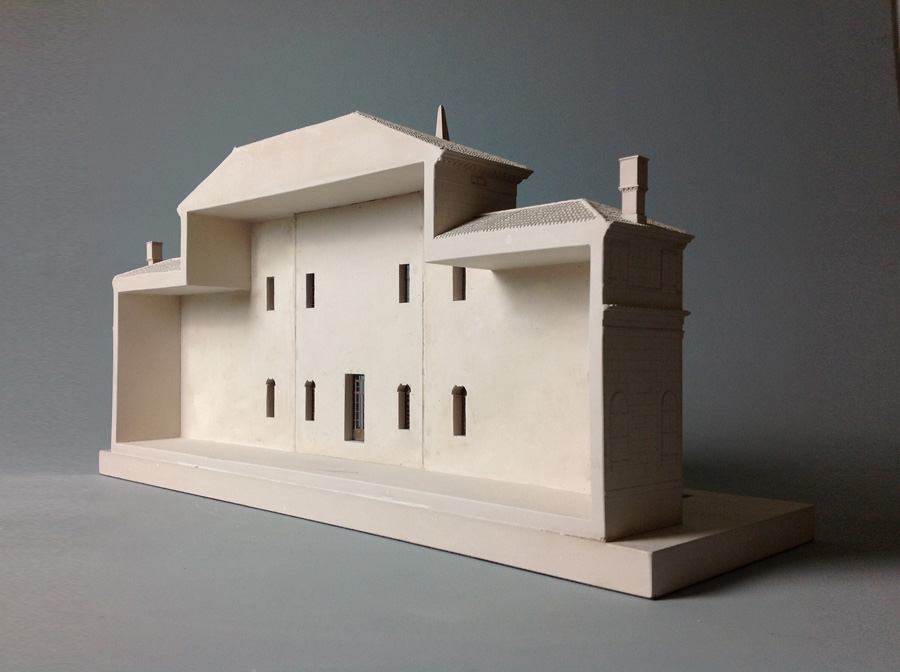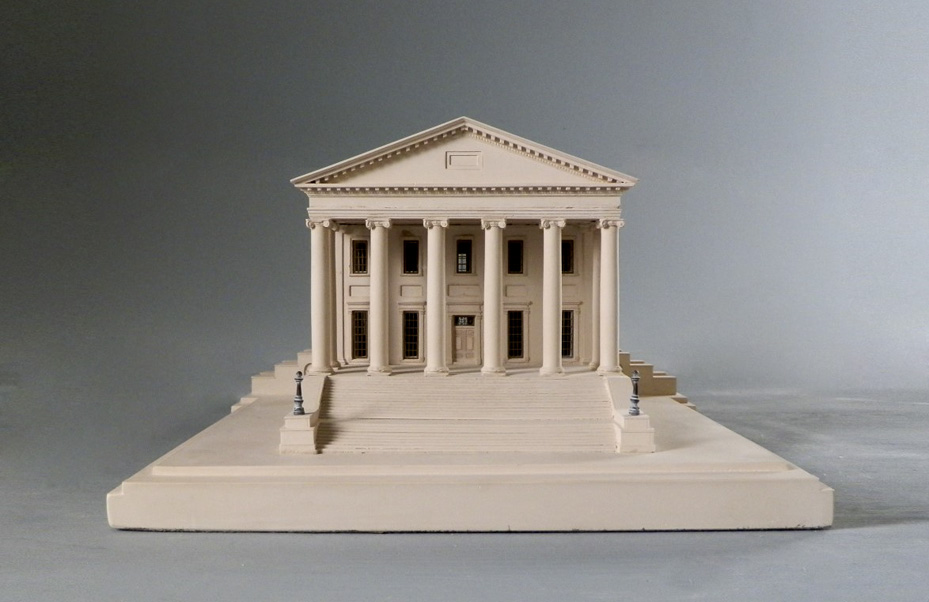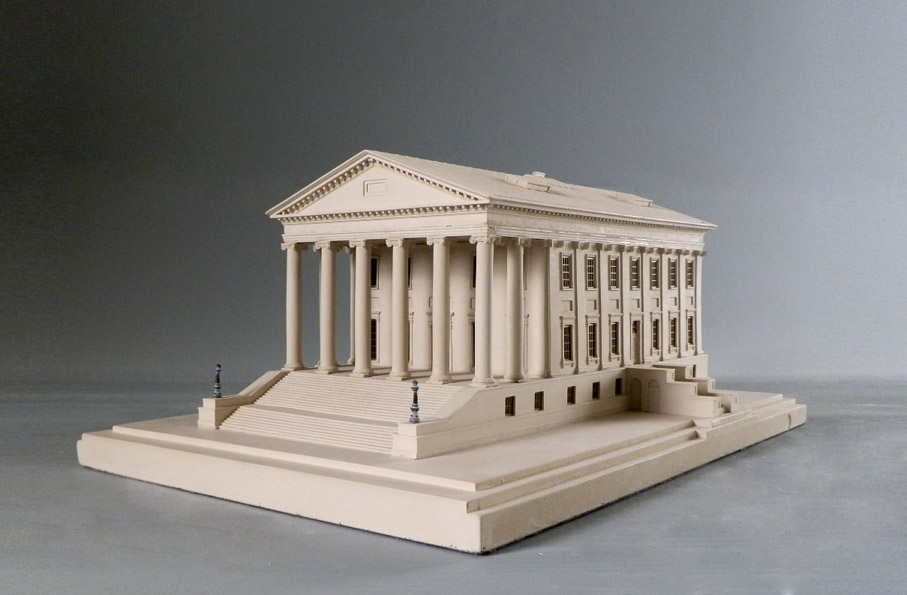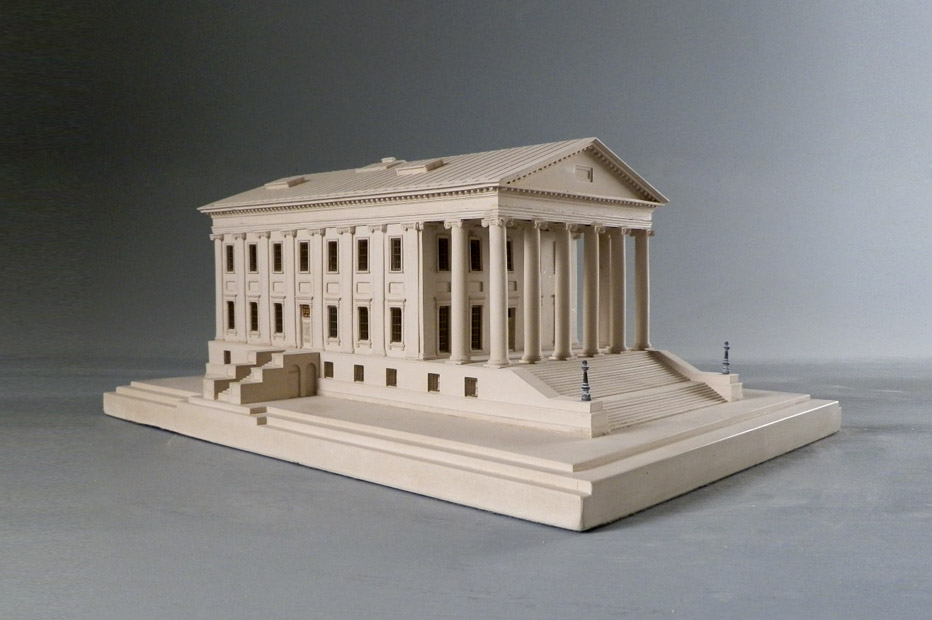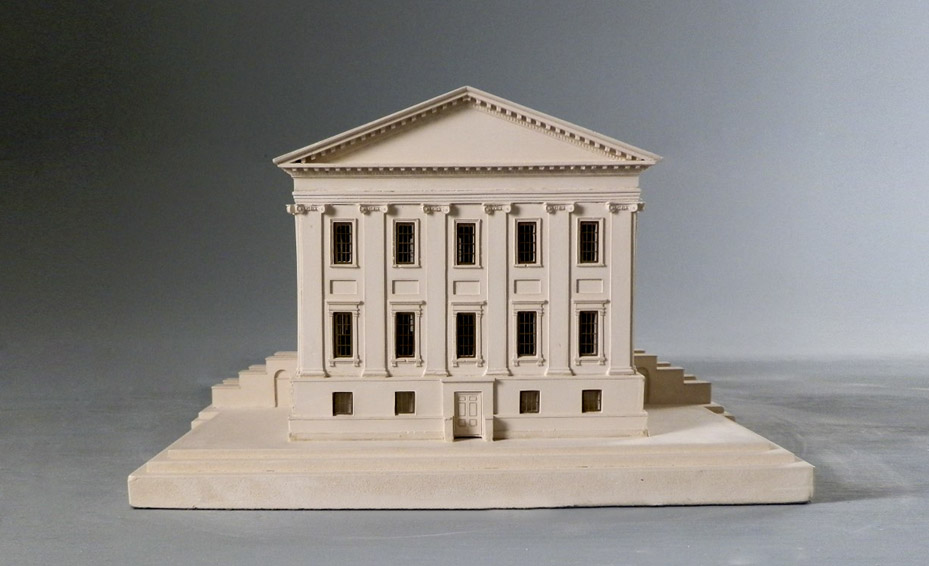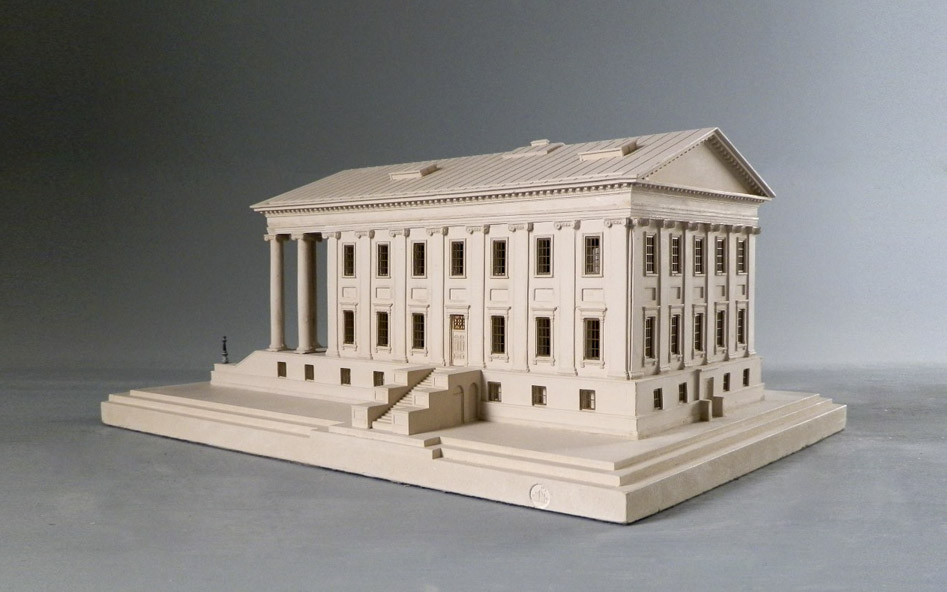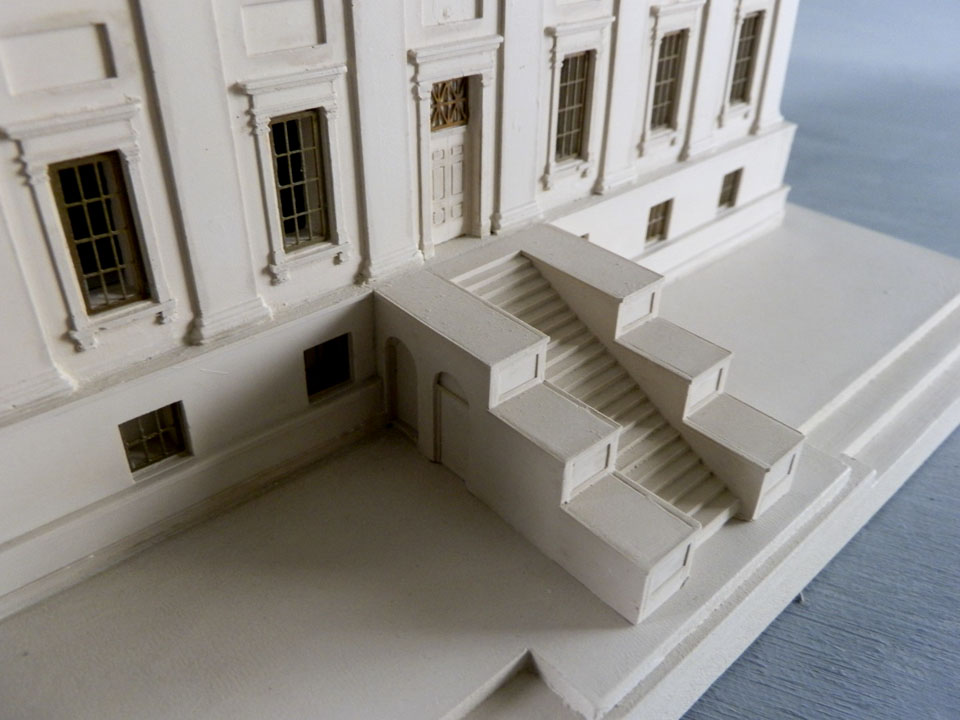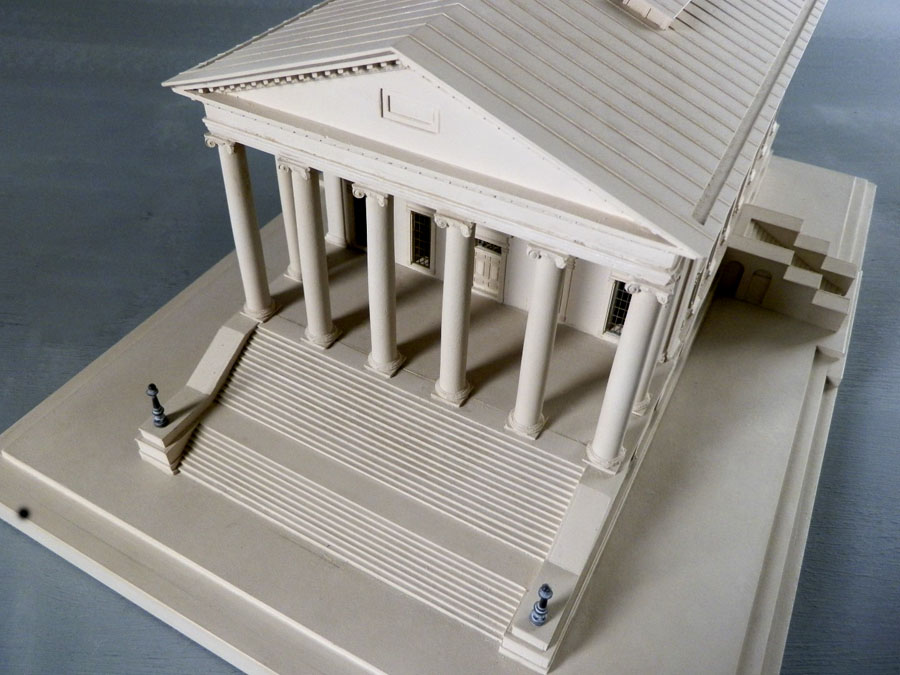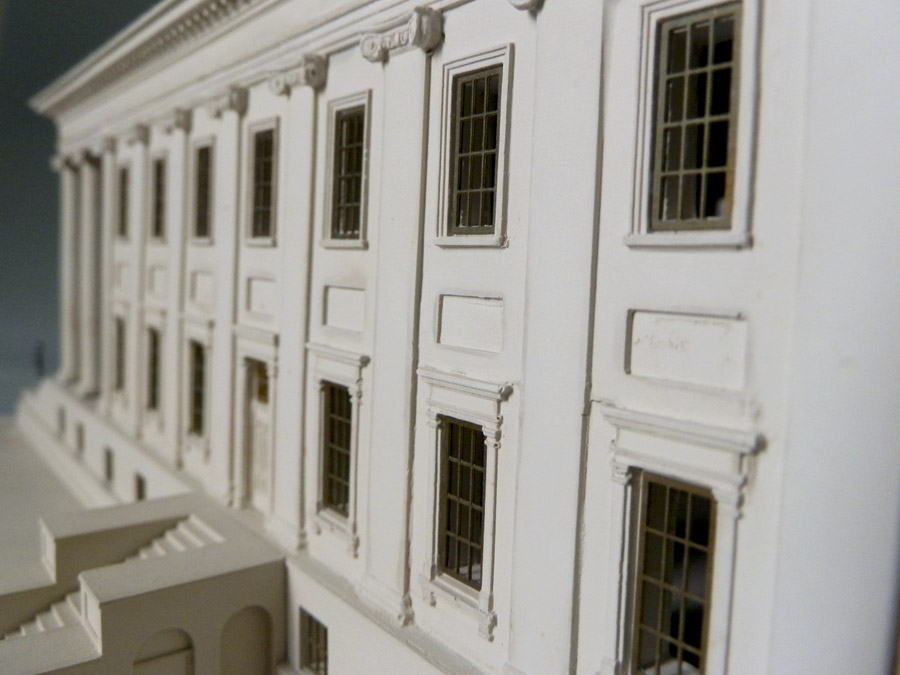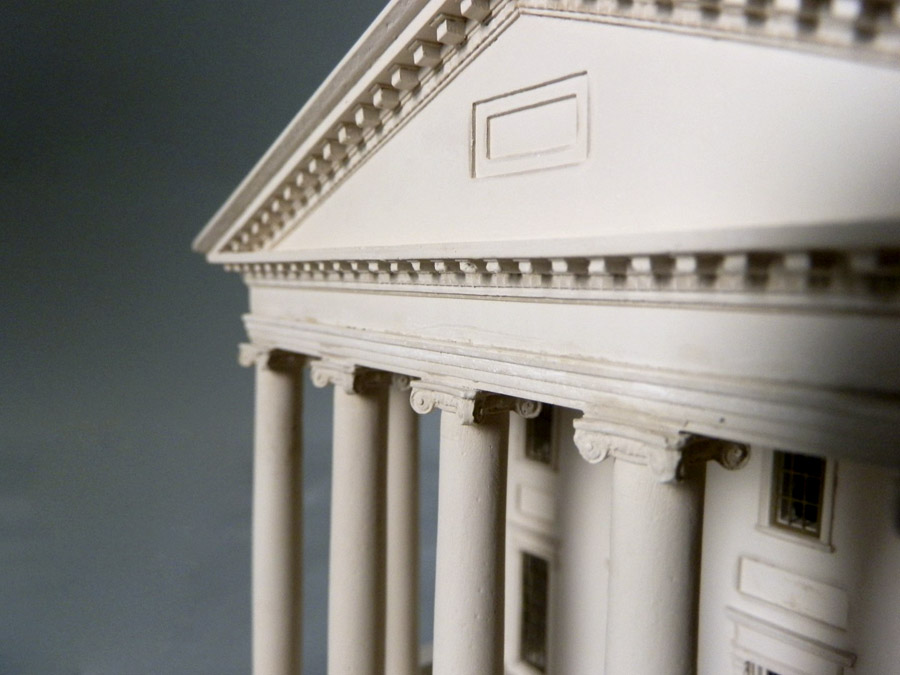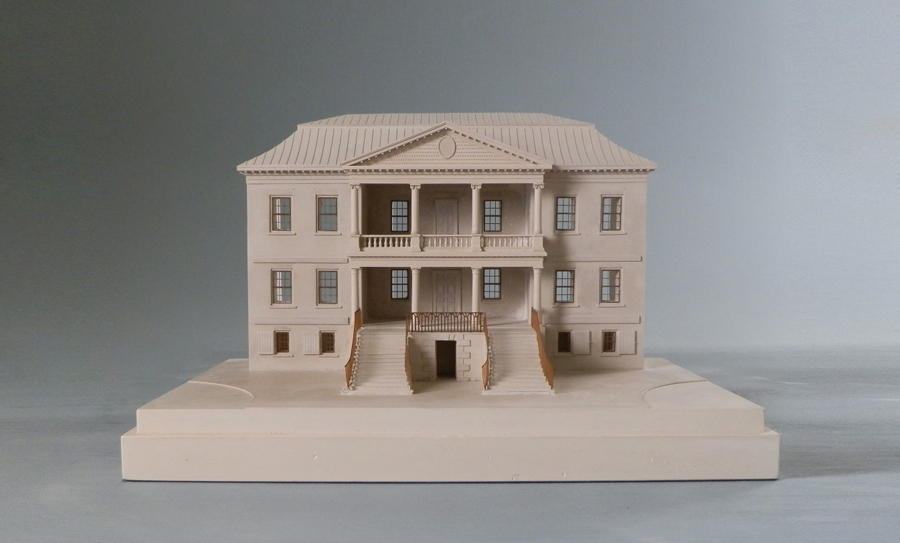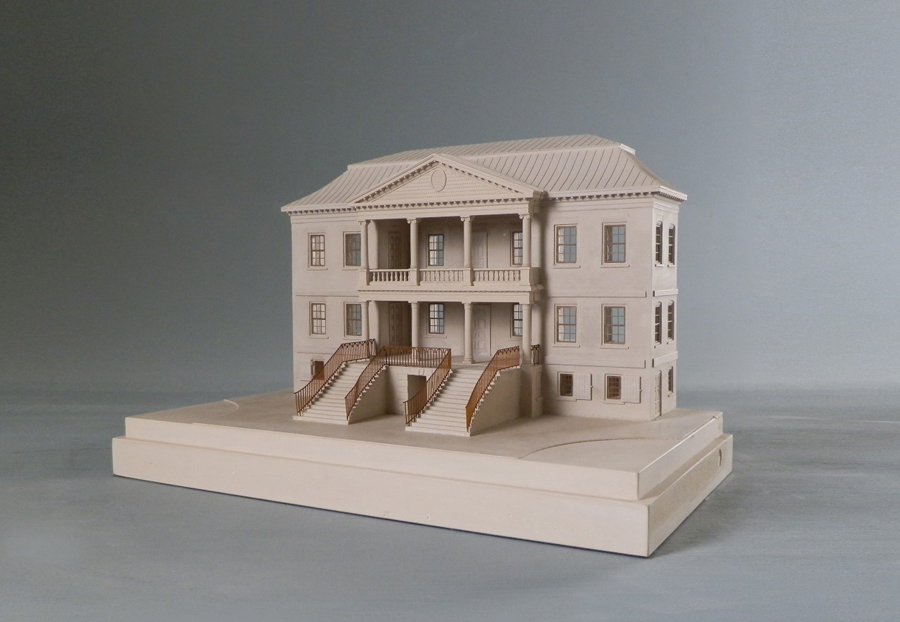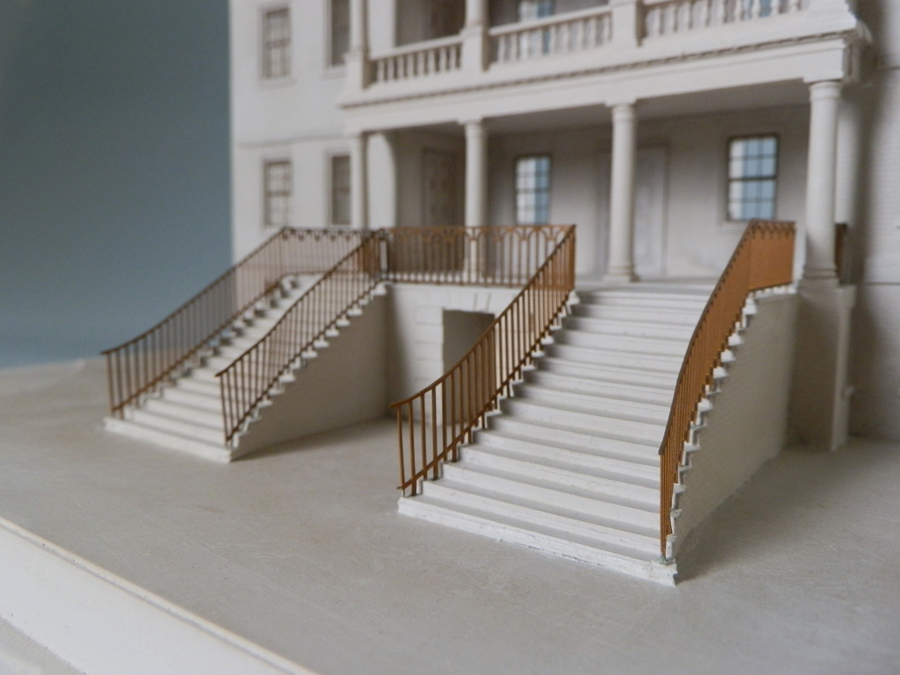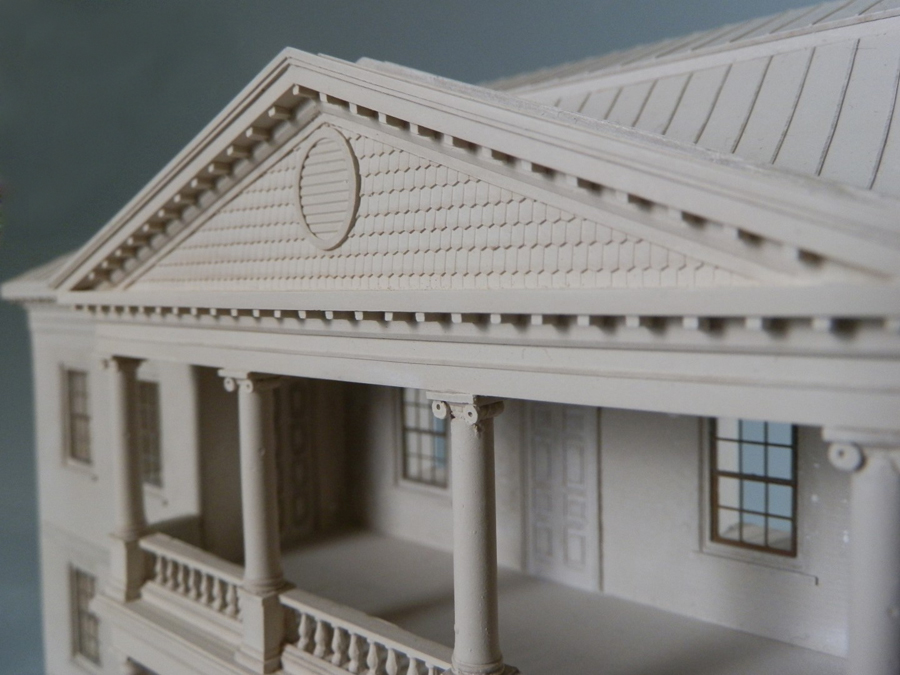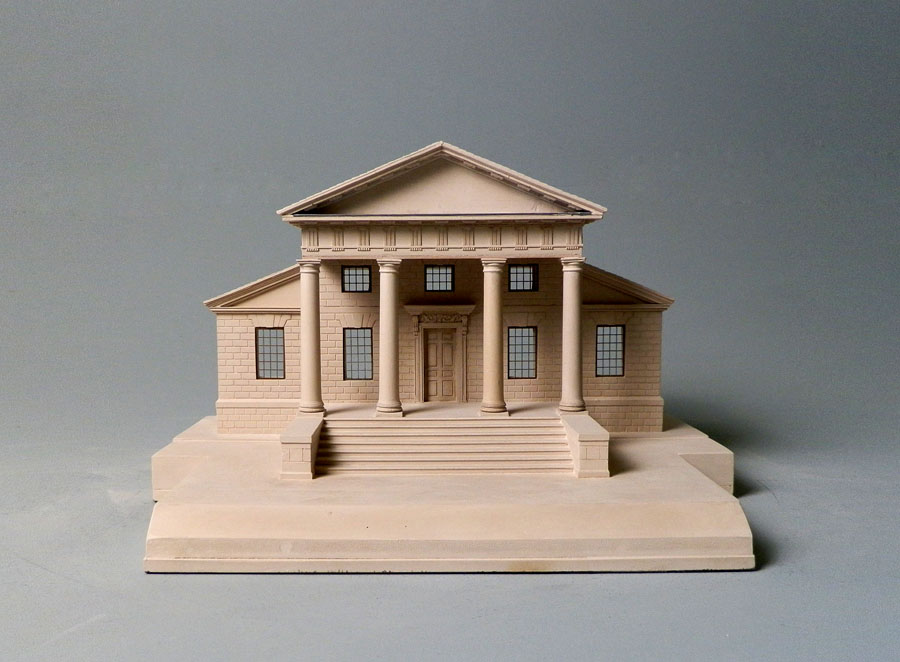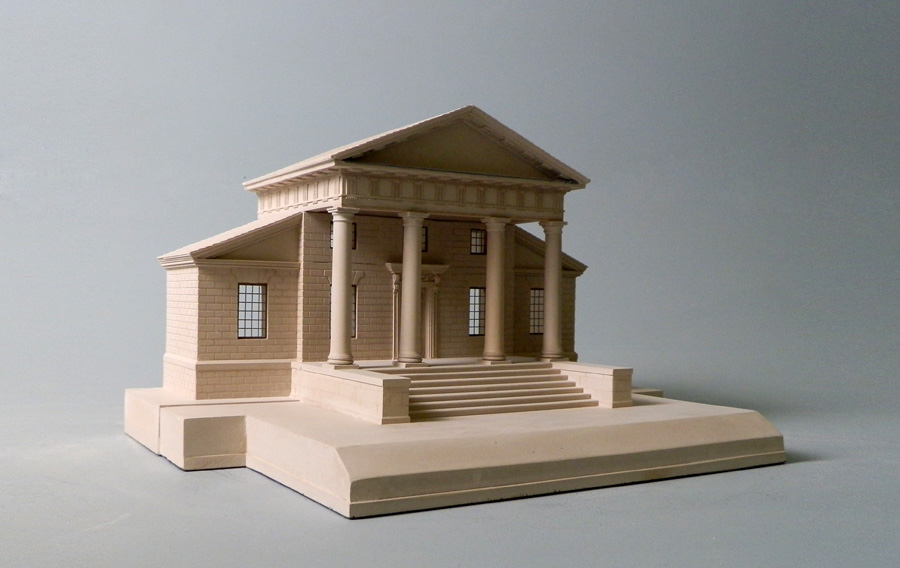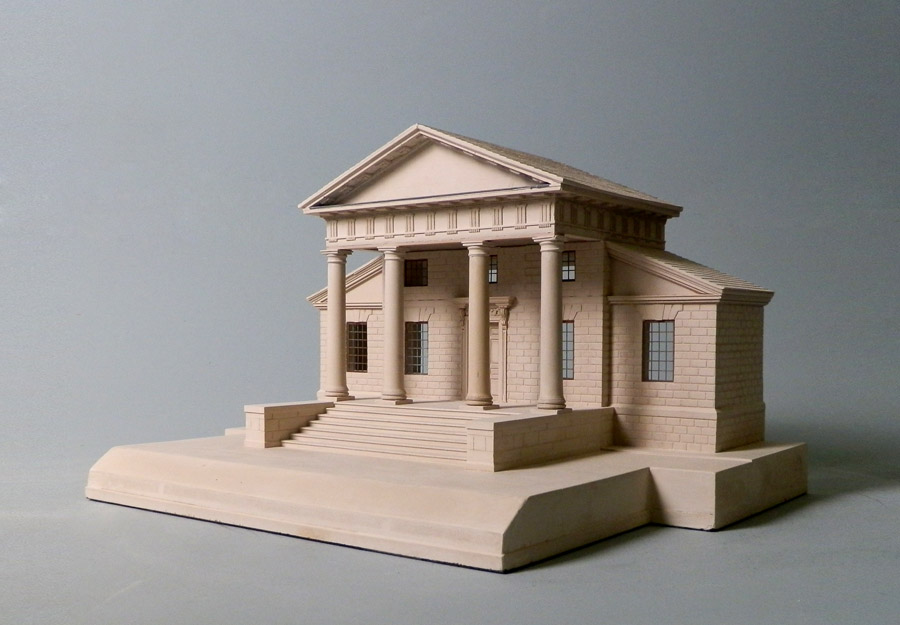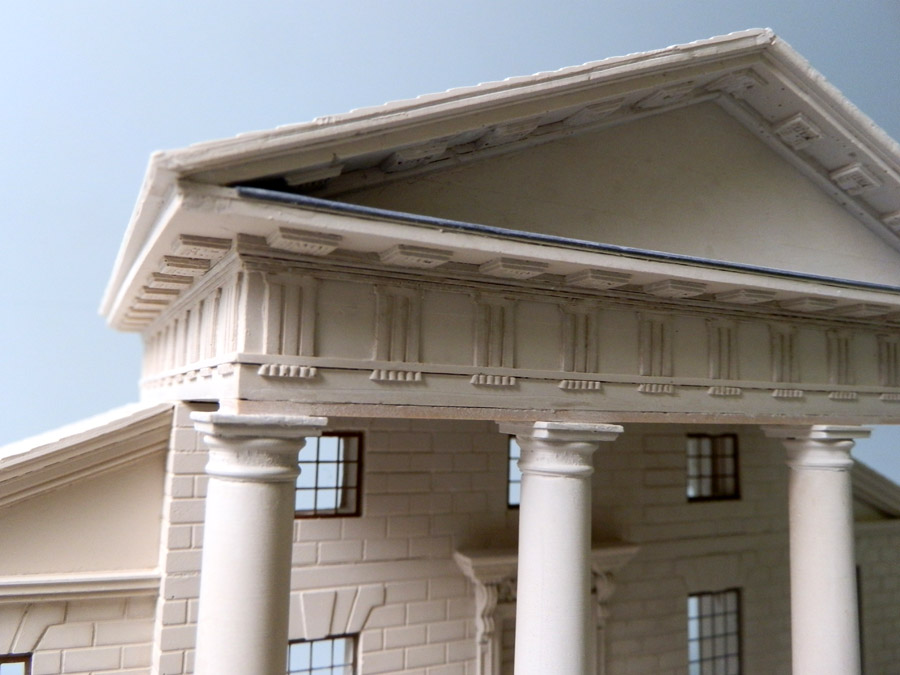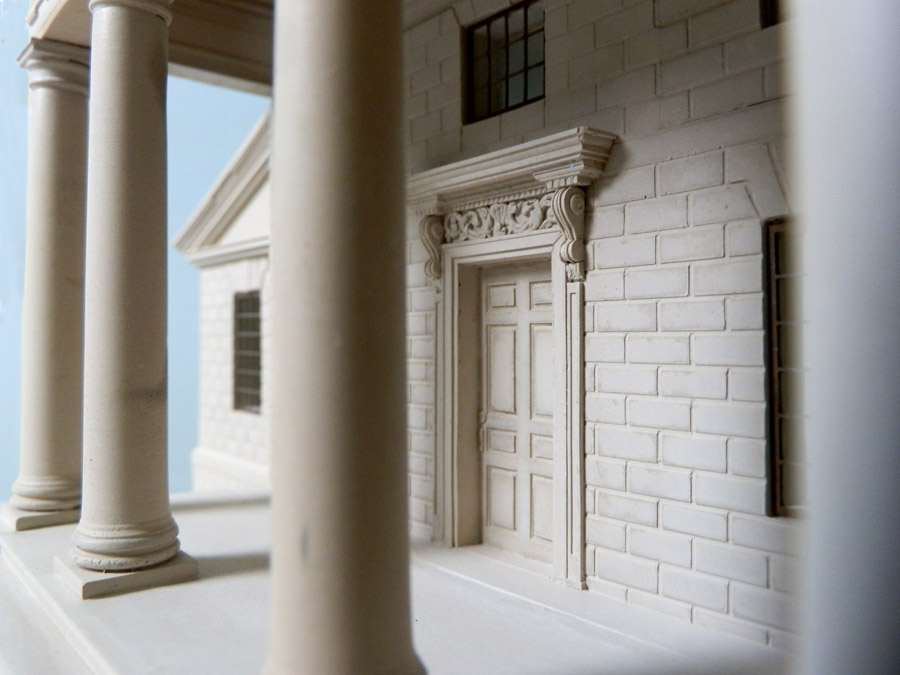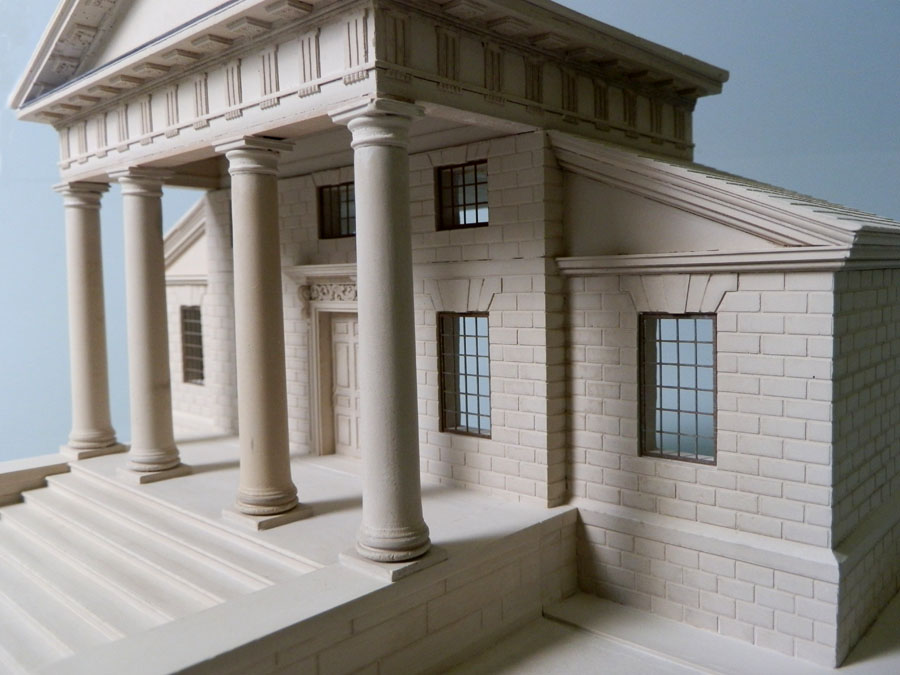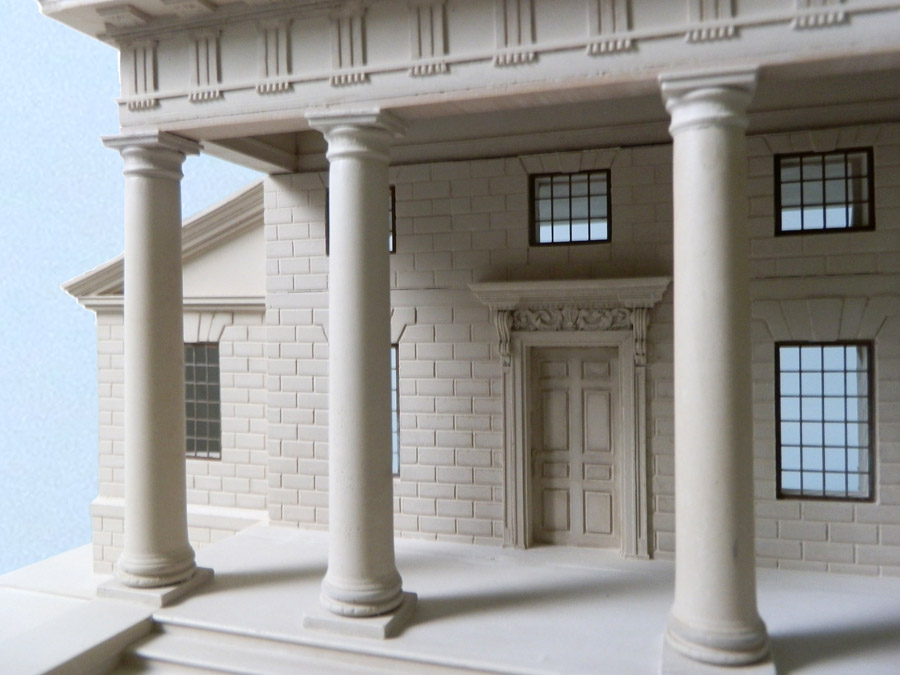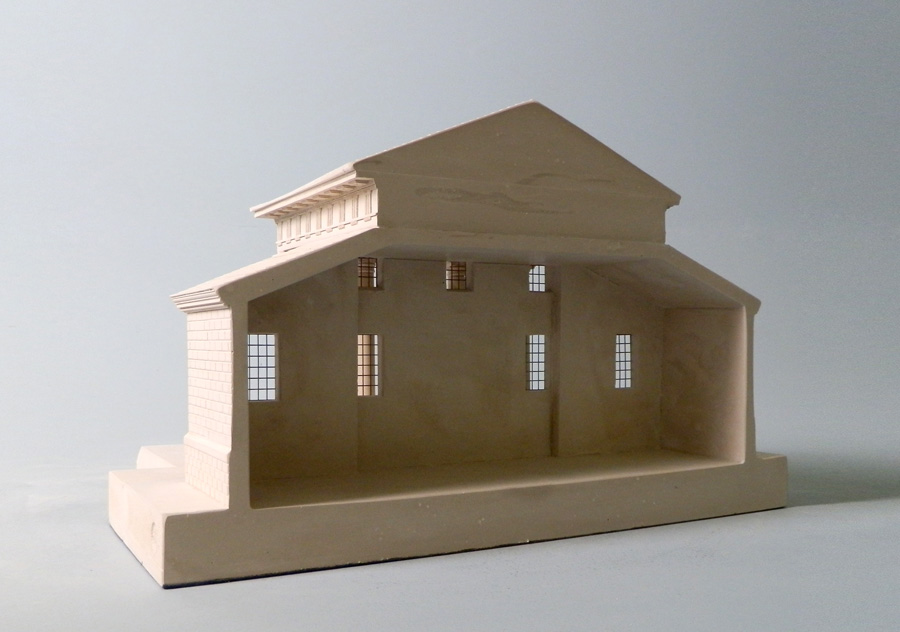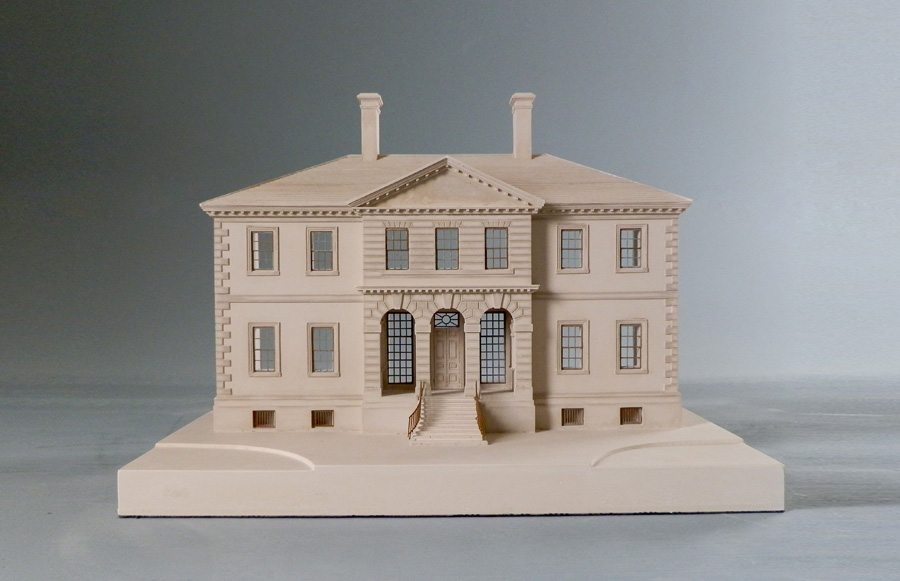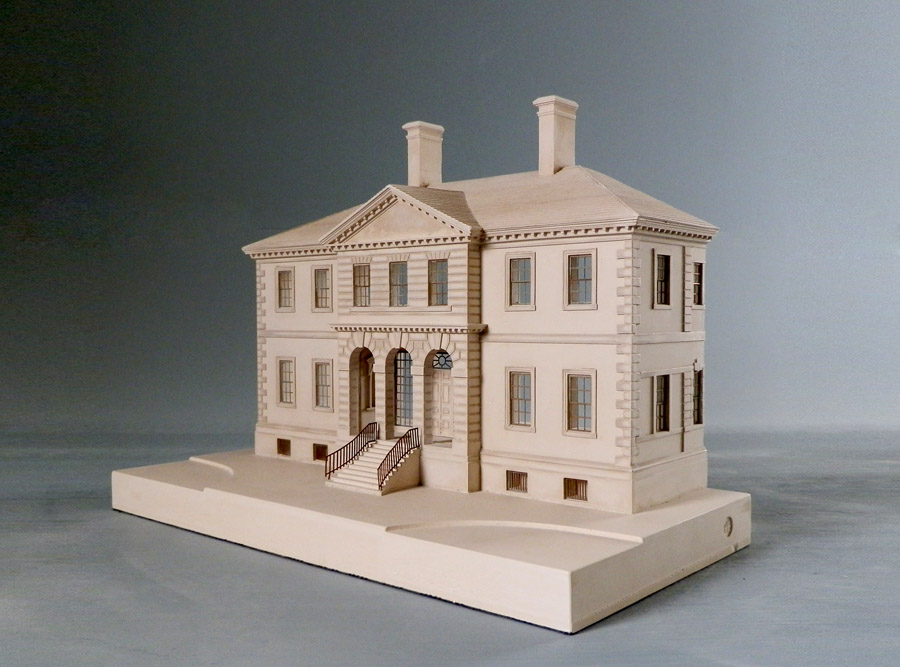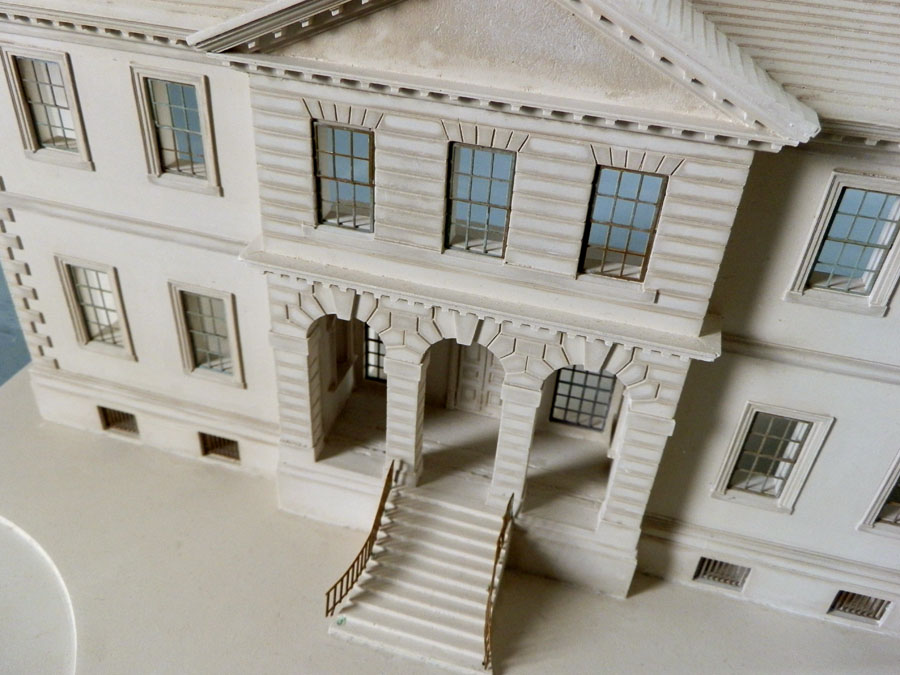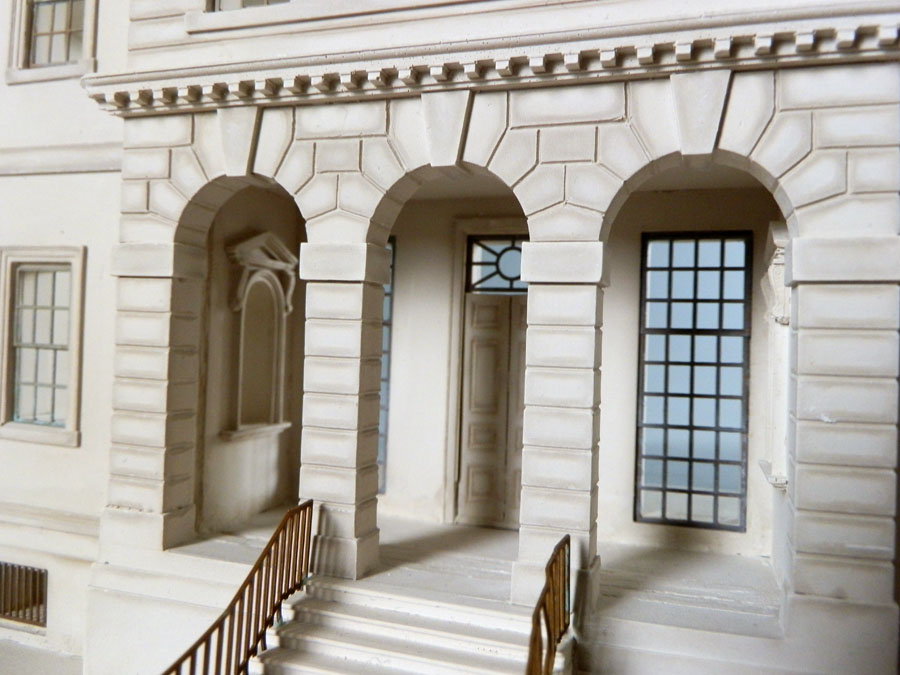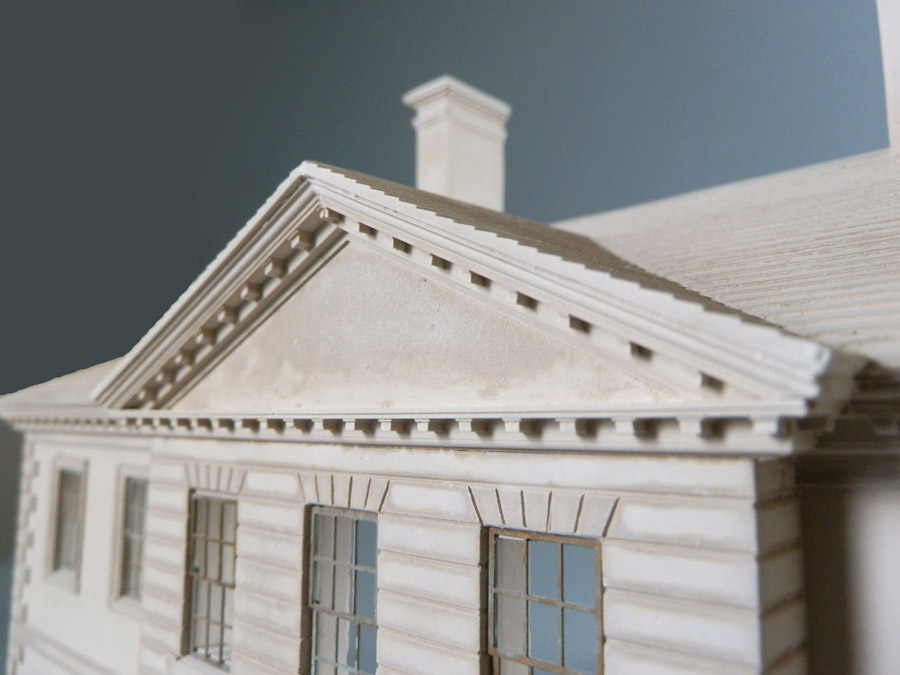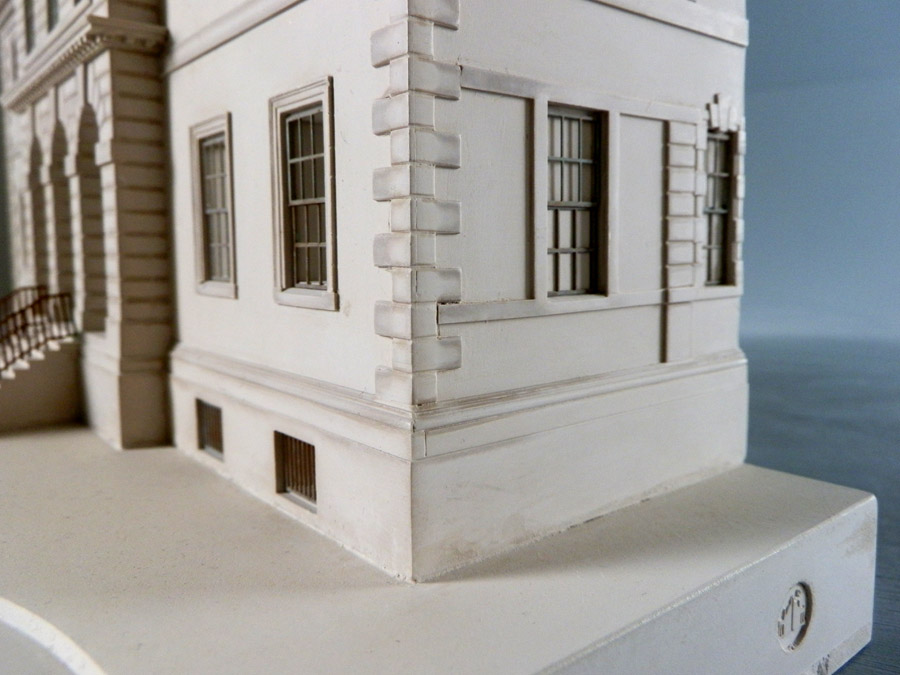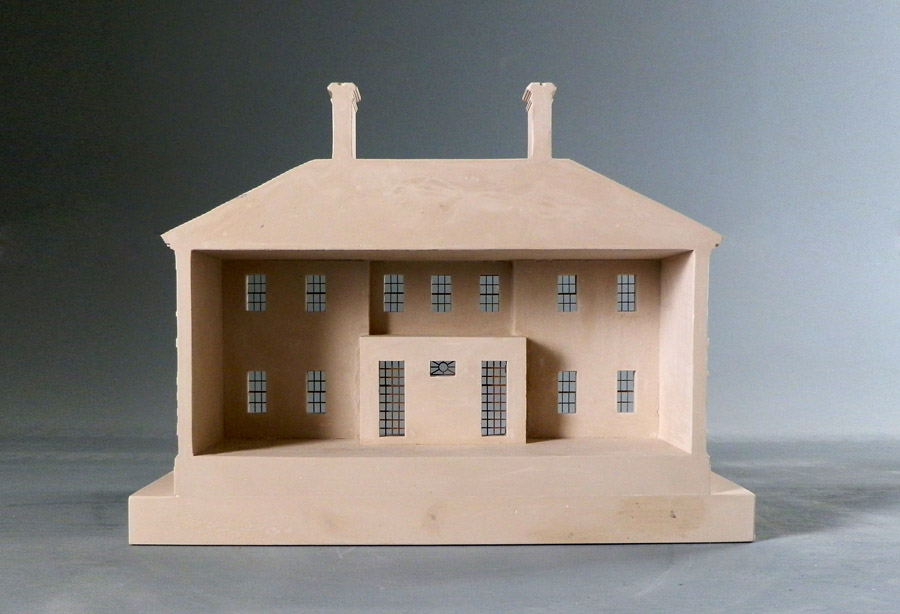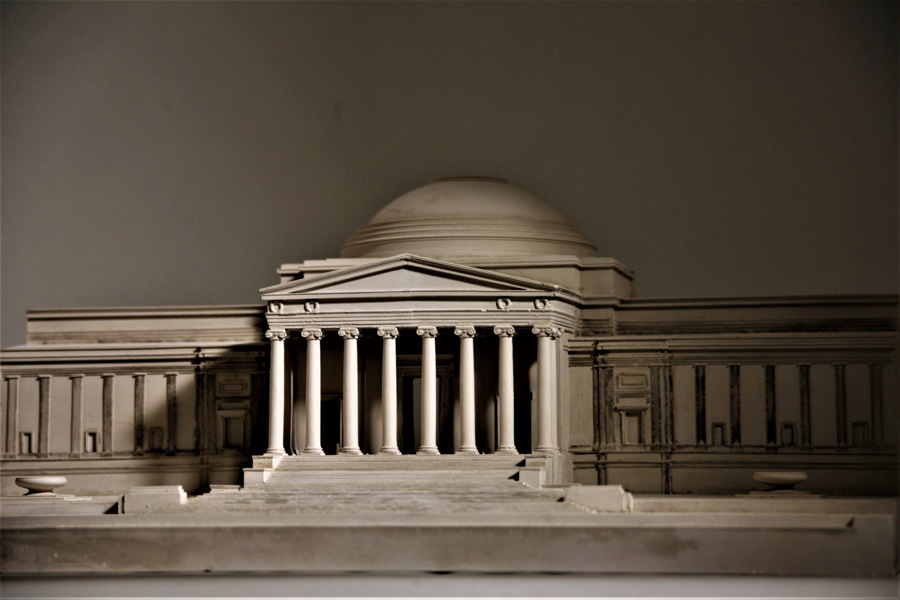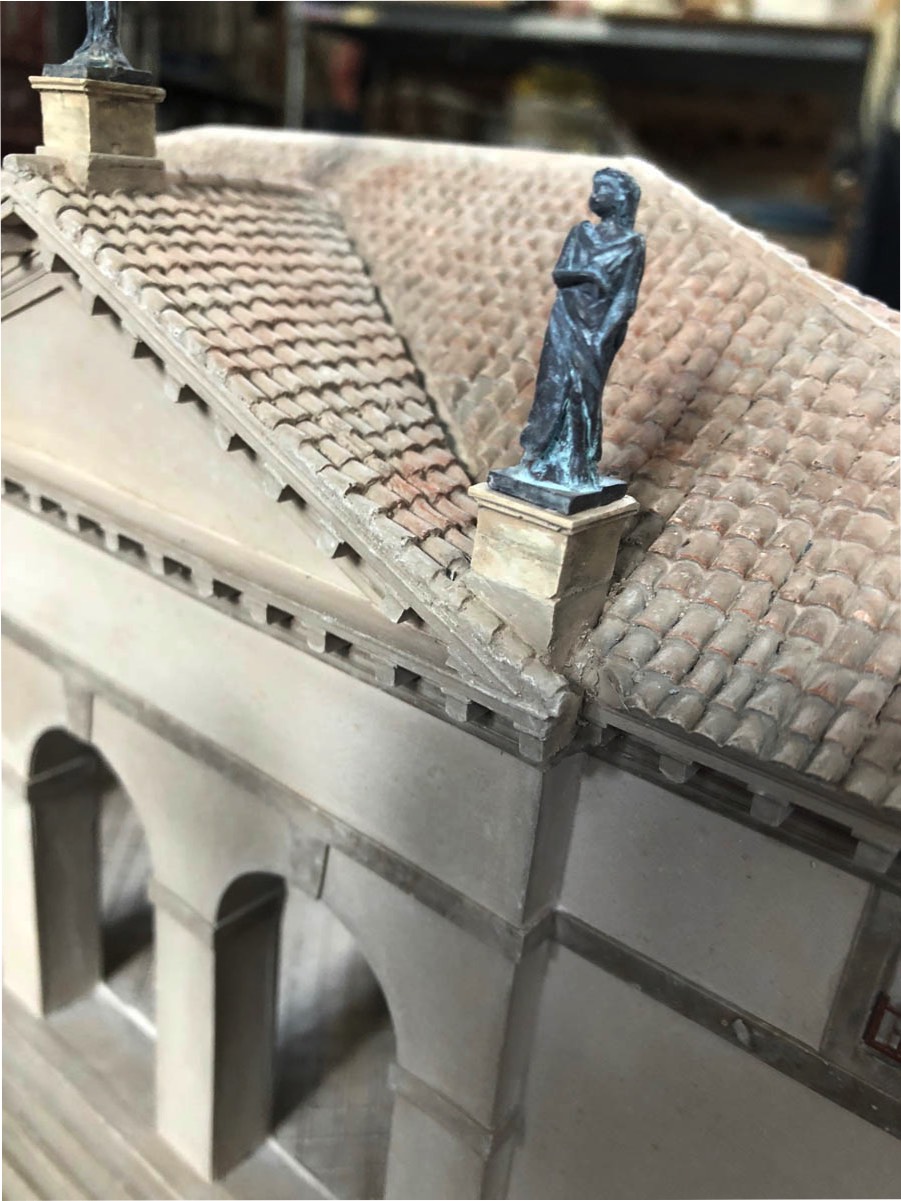
Limited Editions
Palladian
available on this page in alphabetical order
Click on the image to enlarge.
Dimensions:
More Info
Imperial:
Height: 13"
Base: 25
Metric:
Height: 330mm
Width: 635mm
Depth: 635mm
Weight: 24 kg
Disclaimer:
All dimensions, weight and colouring vary due to the natural materials used and the throughout handmade process.
Height: 13"
Base: 25
Metric:
Height: 330mm
Width: 635mm
Depth: 635mm
Weight: 24 kg
Disclaimer:
All dimensions, weight and colouring vary due to the natural materials used and the throughout handmade process.
Design for The Presidents House
Limited Edition of 20
Where: Unbuilt
Who: Designed by Thomas Jefferson
When 1792
Jefferson’s fascination with both Palladio and domes was vividly demonstrated in his proposed design for the United States’ President’s House, submitted anonymously in the 1792 competition for the executive residence.
Where: Unbuilt
Who: Designed by Thomas Jefferson
When 1792
Jefferson’s fascination with both Palladio and domes was vividly demonstrated in his proposed design for the United States’ President’s House, submitted anonymously in the 1792 competition for the executive residence.
More Info
Modelled after Palladio’s Villa Rotonda, Jefferson’s scheme closely paralleled the version of the Rotonda published in Giacomo Leoni’s 1715 edition of Quattro Libri.
Although Leoni took liberties with Palladio’s schemes, mainly adding embellishments, the Leoni edition remained Jefferson’s primary authority for Palladianism.
Jefferson’s submission varied from Leoni’s version of the Villa Rotonda in the use of pairs of bays flanking each of porticoes rather than a single bay, and in the use of free-standing columns rather than arches on the sides of the porticoes.
Although Leoni took liberties with Palladio’s schemes, mainly adding embellishments, the Leoni edition remained Jefferson’s primary authority for Palladianism.
Jefferson’s submission varied from Leoni’s version of the Villa Rotonda in the use of pairs of bays flanking each of porticoes rather than a single bay, and in the use of free-standing columns rather than arches on the sides of the porticoes.
Click on the image to enlarge.
Dimensions:
More Info
Imperial:
Height: 9"
Width: 14"
Depth: 5"
Metric:
Height: 229mm
Width: 336mm
Depth: 127mm
Weight: 6.8 kg
Disclaimer:
All dimensions, weight and colouring vary due to the natural materials used and the throughout handmade process.
Height: 9"
Width: 14"
Depth: 5"
Metric:
Height: 229mm
Width: 336mm
Depth: 127mm
Weight: 6.8 kg
Disclaimer:
All dimensions, weight and colouring vary due to the natural materials used and the throughout handmade process.
Villa Saraceno Veneto
Limited Edition of 380
Designed by Andrea Palladio
When – 1540’s
Where – Vicenza, Italy
The Saraceno family commissioned Palladio to design this Villa in the Provence of Vicenza Italy. The building itself is dated around 1540 and so is considered to be one of Palladio’s earlier works.
Designed by Andrea Palladio
When – 1540’s
Where – Vicenza, Italy
The Saraceno family commissioned Palladio to design this Villa in the Provence of Vicenza Italy. The building itself is dated around 1540 and so is considered to be one of Palladio’s earlier works.
More Info
Although the design was featured in Palladio’s “I Quattro Libri dell’ Architecttura” the constructed version of Villa Saraceno was much more modest; for instance instead of wings being added, the original farm buildings were retained.
As with other Palladian villas, the buildings combine a living space for wealthy owners with something suited to agricultural needs i.e. above the piano nobile is a granary space which keeps the grain cool and dry.
The model was commissioned in 2007 by the Institute of Classical Architecture & Classical America as a prize to be awarded at the Arthur Ross Awards 2008. The recipient of the prize was Mr Alvin Holm A.I.A.
As with other Palladian villas, the buildings combine a living space for wealthy owners with something suited to agricultural needs i.e. above the piano nobile is a granary space which keeps the grain cool and dry.
The model was commissioned in 2007 by the Institute of Classical Architecture & Classical America as a prize to be awarded at the Arthur Ross Awards 2008. The recipient of the prize was Mr Alvin Holm A.I.A.
Click on the image to enlarge.
Dimensions:
More Info
Imperial:
Height: 16.5"
Width: 6.5"
Depth: 7"
Metric:
Height: 406mm
Width: 216mm
Depth: 292mm
Weight: 6kg
Disclaimer:
All dimensions, weight and colouring vary due to the natural materials used and the throughout handmade process.
Height: 16.5"
Width: 6.5"
Depth: 7"
Metric:
Height: 406mm
Width: 216mm
Depth: 292mm
Weight: 6kg
Disclaimer:
All dimensions, weight and colouring vary due to the natural materials used and the throughout handmade process.
The White House Washington DC
Limited Edition of 300
Designed by James Hoban
When – 1887
Where – Washington, USA
In 1792 a competition was held for the design of the President’s House.
Designed by James Hoban
When – 1887
Where – Washington, USA
In 1792 a competition was held for the design of the President’s House.
More Info
George Washington and the three competition commissioners passed over Jefferson’s Rotonda scheme and selected the more conservative design submitted by the Irish-born architect James Hoban.
Hoban’s design followed the Anglo-Palladian country house tradition rather than that of a villa of the Veneto.
Originally built without the projecting north portico (added in 1829), the White House bore a strong similarity to Seacomb Park, Hertfordshire, a country house illustrated in Gibbs’ “A Book of Architecture.”
Following the death of the client, Seacomb Park was never realised.
Hoban’s design followed the Anglo-Palladian country house tradition rather than that of a villa of the Veneto.
Originally built without the projecting north portico (added in 1829), the White House bore a strong similarity to Seacomb Park, Hertfordshire, a country house illustrated in Gibbs’ “A Book of Architecture.”
Following the death of the client, Seacomb Park was never realised.
Click on the image to enlarge.
Dimensions:
More Info
Imperial:
Height: 8.5"
Width: 17.5"
Depth: 7"
Metric:
Height: 445mm
Width: 216mm
Depth: 292mm
Weight: 6.9kg
Disclaimer:
All dimensions, weight and colouring vary due to the natural materials used and the throughout handmade process.
Height: 8.5"
Width: 17.5"
Depth: 7"
Metric:
Height: 445mm
Width: 216mm
Depth: 292mm
Weight: 6.9kg
Disclaimer:
All dimensions, weight and colouring vary due to the natural materials used and the throughout handmade process.
The First Monticello
Limited Edition of 100
Where: Virginia
Designed by Thomas Jefferson
When: 1771
DESIGN FOR THE FIRST MONTICELLO: Thomas Jefferson determined that his home, Monticello, should be a model for the correct use of the Classical orders.
Where: Virginia
Designed by Thomas Jefferson
When: 1771
DESIGN FOR THE FIRST MONTICELLO: Thomas Jefferson determined that his home, Monticello, should be a model for the correct use of the Classical orders.
More Info
This was a rarity in Virginia where Jefferson wrote: “a workman could scarcely be found capable of drawing an order.”
His passion for Palladian design as well as proper application of the orders is conspicuously demonstrated in his 1771 elevation drawing of the first version of the house, which began around 1772.
The two-tiered portico, superimposed orders, and hipped-roof wings with attic stories made the original Monticello a reduced version of Palladio’s Villa Cornaro. Jefferson ‘s enthusiasm for Classical details extended to his chimneys which are Classical pedestals.
Monticello’s first version was a precedent-setting tripartite scheme for America, but it was never fully completed.
Following his return from France in 1789, Jefferson transformed the unfinished house into the domed version we know today, a combination of Palladian and French Neoclassical influences.
His passion for Palladian design as well as proper application of the orders is conspicuously demonstrated in his 1771 elevation drawing of the first version of the house, which began around 1772.
The two-tiered portico, superimposed orders, and hipped-roof wings with attic stories made the original Monticello a reduced version of Palladio’s Villa Cornaro. Jefferson ‘s enthusiasm for Classical details extended to his chimneys which are Classical pedestals.
Monticello’s first version was a precedent-setting tripartite scheme for America, but it was never fully completed.
Following his return from France in 1789, Jefferson transformed the unfinished house into the domed version we know today, a combination of Palladian and French Neoclassical influences.
Click on the image to enlarge.
Dimensions:
More Info
Imperial:
Height: 19"
Width: 9"
Depth: 5.5"
Metric:
Height: 483mm
Width: 229mm
Depth: 140mm
Weight: 6.5kg
Disclaimer:
All dimensions, weight and colouring vary due to the natural materials used and the throughout handmade process.
Height: 19"
Width: 9"
Depth: 5.5"
Metric:
Height: 483mm
Width: 229mm
Depth: 140mm
Weight: 6.5kg
Disclaimer:
All dimensions, weight and colouring vary due to the natural materials used and the throughout handmade process.
Homewood House Baltimore
Limited Edition of 100
1801-1803
Designer: Charles Carroll, Jr
John Hopkins University, Baltimore: With his design for the Villa Barbaro, Palladio showed how incorporating service and storage sections into a formal composition could make a villa an impressive architectural statement.
1801-1803
Designer: Charles Carroll, Jr
John Hopkins University, Baltimore: With his design for the Villa Barbaro, Palladio showed how incorporating service and storage sections into a formal composition could make a villa an impressive architectural statement.
More Info
The Villa Barbaro’s five-part format became the prototype for numerous 18th- and 19th-century high-style residences throughout the eastern United States.
This five-part layout is elegantly expressed in Homewood, the suburban villa of Charles Carroll, Jr.
While its form is Palladian, Homewood’s refined detailing is Adamesque, making the house a demonstration of Palladianism expressed with a different Classical vocabulary.
Homewood was largely planned by Carroll himself, who was well-educated and well-informed on the subject of architecture. Much of Homewood’s detailing is based on illustrations in English pattern books by William Pain, including Pain’s British Palladio.
Homewood is now a museum owned and administered by Johns Hopkins University.
Dimensions: 19″w x 5.5″h x 9″d
Weight: 14.3lbs
This five-part layout is elegantly expressed in Homewood, the suburban villa of Charles Carroll, Jr.
While its form is Palladian, Homewood’s refined detailing is Adamesque, making the house a demonstration of Palladianism expressed with a different Classical vocabulary.
Homewood was largely planned by Carroll himself, who was well-educated and well-informed on the subject of architecture. Much of Homewood’s detailing is based on illustrations in English pattern books by William Pain, including Pain’s British Palladio.
Homewood is now a museum owned and administered by Johns Hopkins University.
Dimensions: 19″w x 5.5″h x 9″d
Weight: 14.3lbs
Click on the image to enlarge.
Dimensions:
More Info
Imperial:
Height: 8"
Width: 16"
Depth: 9.5"
Metric:
Height: 406mm
Width: 203mm
Depth: 241mm
Weight: 7kg
Disclaimer:
All dimensions, weight and colouring vary due to the natural materials used and the throughout handmade process.
Height: 8"
Width: 16"
Depth: 9.5"
Metric:
Height: 406mm
Width: 203mm
Depth: 241mm
Weight: 7kg
Disclaimer:
All dimensions, weight and colouring vary due to the natural materials used and the throughout handmade process.
Villa Cornaro, Veneto, Italy
Limited Edition of 200
Designed by Andrea Palladio
When – 1554
Where – Piombino Dese, Italy
Villa Cornaro is situated to the north west of Venice, Italy. Andrea Palladio designed this Villa in 1552 and included it in his “I Quattro Libri dell’ Architecttura”.
Designed by Andrea Palladio
When – 1554
Where – Piombino Dese, Italy
Villa Cornaro is situated to the north west of Venice, Italy. Andrea Palladio designed this Villa in 1552 and included it in his “I Quattro Libri dell’ Architecttura”.
More Info
The Villa was built for Giorgio Cornaro between 1553-1554. After Palladio’s death additional work was carried on into the 1590s.
The symmetrical floor plan is composed of squares and rectangles of inter-related proportions which flank a central axial vista extending through the villa.
An outdoor living space is created with a central portico-loggia which allows cooling breezes to flow through a shaded area. Villa Cornaro inspired Villas all over the world including colonial America and England.
The symmetrical floor plan is composed of squares and rectangles of inter-related proportions which flank a central axial vista extending through the villa.
An outdoor living space is created with a central portico-loggia which allows cooling breezes to flow through a shaded area. Villa Cornaro inspired Villas all over the world including colonial America and England.
Click on the image to enlarge.
Dimensions:
More Info
Imperial:
Height: 9"
Width: 15"
Depth: 7"
Metric:
Height: 406mm
Width: 381mm
Depth: 178mm
Weight: 7kg
Disclaimer:
All dimensions, weight and colouring vary due to the natural materials used and the throughout handmade process.
Height: 9"
Width: 15"
Depth: 7"
Metric:
Height: 406mm
Width: 381mm
Depth: 178mm
Weight: 7kg
Disclaimer:
All dimensions, weight and colouring vary due to the natural materials used and the throughout handmade process.
Virginia State Capitol, Richmond
Limited Edition of 200
Where: Richmond, Virginia
Designed by Thomas Jefferson
When: Circa 1788
For the design of Virginia’s new Capitol, Jefferson drew inspiration from the Maison Carree, the near-perfectly preserved Roman temple in Nimes, France.
Where: Richmond, Virginia
Designed by Thomas Jefferson
When: Circa 1788
For the design of Virginia’s new Capitol, Jefferson drew inspiration from the Maison Carree, the near-perfectly preserved Roman temple in Nimes, France.
More Info
Although Jefferson had visited the temple and had studied its design in Charles Clerisseau’s 1778 Antiquities of France, he was first introduced to images of the building in his copy of Palladio’s Quattro Libri.
With Clerisseau’s assistance, Jefferson produced design drawings for the Capitol which he sent from France to Richmond along with a plaster model crafted by the celebrated French model maker, Jean-Pierre Fouquet.
Jefferson’s design substituted the Maison Carree’s Corinthian order with an Ionic order.
Further modifications were made during construction. However, in sitting the Capitol, Jefferson followed Palladio’s dictum for temples which he said should be: “far away from unsavoury areas and on beautiful and ornate squares where many streets end … And if there are hills in the city, one should choose the highest part.”
Dimensions: 9″w x 7″h x 15″d
With Clerisseau’s assistance, Jefferson produced design drawings for the Capitol which he sent from France to Richmond along with a plaster model crafted by the celebrated French model maker, Jean-Pierre Fouquet.
Jefferson’s design substituted the Maison Carree’s Corinthian order with an Ionic order.
Further modifications were made during construction. However, in sitting the Capitol, Jefferson followed Palladio’s dictum for temples which he said should be: “far away from unsavoury areas and on beautiful and ornate squares where many streets end … And if there are hills in the city, one should choose the highest part.”
Dimensions: 9″w x 7″h x 15″d
Click on the image to enlarge.
Dimensions:
More Info
Imperial:
Height: 8.5"
Width: 13"
Depth: 8"
Metric:
Height: 216mm
Width: 330mm
Depth: 203mm
Weight: 7kg
Disclaimer:
All dimensions, weight and colouring vary due to the natural materials used and the throughout handmade process.
Height: 8.5"
Width: 13"
Depth: 8"
Metric:
Height: 216mm
Width: 330mm
Depth: 203mm
Weight: 7kg
Disclaimer:
All dimensions, weight and colouring vary due to the natural materials used and the throughout handmade process.
Drayton Hall
Limited Edition of 100
Drayton Hall is an 18th-century plantation located on the Ashley River about 15 miles (24 km) northwest of Charleston, North Carolina. An outstanding example of Palladian architecture in North America and the only plantation house on the Ashley River to survive intact through both the Revolutionary and Civil wars, it is a National Historic Landmark.
Drayton Hall is an 18th-century plantation located on the Ashley River about 15 miles (24 km) northwest of Charleston, North Carolina. An outstanding example of Palladian architecture in North America and the only plantation house on the Ashley River to survive intact through both the Revolutionary and Civil wars, it is a National Historic Landmark.
More Info
Click on the image to enlarge.
Dimensions:
More Info
Imperial:
Height: 9.5"
Width: 13"
Depth: 7.5"
Metric:
Height: 241mm
Width: 330mm
Depth: 191mm
Weight: 6kg
Disclaimer:
All dimensions, weight and colouring vary due to the natural materials used and the throughout handmade process.
Height: 9.5"
Width: 13"
Depth: 7.5"
Metric:
Height: 241mm
Width: 330mm
Depth: 191mm
Weight: 6kg
Disclaimer:
All dimensions, weight and colouring vary due to the natural materials used and the throughout handmade process.
Redwood Library Newport
Limited Edition of 50
When: 18th Century
The original section of the building was constructed built between 1748 and 1750 by architect Peter Harrison.
When: 18th Century
The original section of the building was constructed built between 1748 and 1750 by architect Peter Harrison.
More Info
The Redwood Library and Athenaeum predates the Charleston Library Society (founded in 1748), New York Society Library (founded in 1754), and the Boston Athenaeum (founded in 1807).
It was the first classical public building built in America, designed in the manner of Italian Renaissance Architect Andrea Palladio, in the Georgian Palladian style.
The main facade facing Bellevue avenue is based upon a plate in Edward Hoppus' Andrea Palladio's Architecture published in 1735. The oldest section, today called the Harrison Room, still houses the majority of the original books that were purchased as a collection in London.
Occupying British troops allegedly looted numerous books (many of which were later returned) prior to the Battle of Rhode Island during the American Revolution.
19th Century
In 1833 the Library furthered its abilities as an institution, and re established itself as The Company of the Redwood Library and Athenaeum.
By 1858, membership and collection had grown so much as that an expansion was needed. This expansion, which became known as the Roderick Terry Reading Room was produced by George Snell of Boston.
Harrison's architecture.
In 1875, plans did go forward to develop another expansion to the Library. The Rovensky Delivery Room was designed by famed architect George Champlin Mason.
20th Century
In 1915, historian and architect Norman Isham restored the eighteenth century Harrison room to what he concluded was its original appearance. The Library's modern collection now includes more than 200,000 volumes as well as a museum collection of art and artefacts. The building was designated a National Historical Landmark in 1966.
It was the first classical public building built in America, designed in the manner of Italian Renaissance Architect Andrea Palladio, in the Georgian Palladian style.
The main facade facing Bellevue avenue is based upon a plate in Edward Hoppus' Andrea Palladio's Architecture published in 1735. The oldest section, today called the Harrison Room, still houses the majority of the original books that were purchased as a collection in London.
Occupying British troops allegedly looted numerous books (many of which were later returned) prior to the Battle of Rhode Island during the American Revolution.
19th Century
In 1833 the Library furthered its abilities as an institution, and re established itself as The Company of the Redwood Library and Athenaeum.
By 1858, membership and collection had grown so much as that an expansion was needed. This expansion, which became known as the Roderick Terry Reading Room was produced by George Snell of Boston.
Harrison's architecture.
In 1875, plans did go forward to develop another expansion to the Library. The Rovensky Delivery Room was designed by famed architect George Champlin Mason.
20th Century
In 1915, historian and architect Norman Isham restored the eighteenth century Harrison room to what he concluded was its original appearance. The Library's modern collection now includes more than 200,000 volumes as well as a museum collection of art and artefacts. The building was designated a National Historical Landmark in 1966.
Click on the image to enlarge.
Dimensions:
More Info
Imperial:
Height: 9"
Width: 13"
Depth: 7"
Metric:
Height: 229mm
Width: 330mm
Depth: 178mm
Weight: 6kg
Disclaimer:
All dimensions, weight and colouring vary due to the natural materials used and the throughout handmade process.
Height: 9"
Width: 13"
Depth: 7"
Metric:
Height: 229mm
Width: 330mm
Depth: 178mm
Weight: 6kg
Disclaimer:
All dimensions, weight and colouring vary due to the natural materials used and the throughout handmade process.
Mount Airy Richmond
Limited Edition of 50
The great home once played host to General and Mrs. George Washington and the Marquis de Lafayette and his wife Marie and has welcomed presidents, senators, and diplomats from across the world to view its gracious architectural design and enjoy its many comforts for close to three hundred years.
The great home once played host to General and Mrs. George Washington and the Marquis de Lafayette and his wife Marie and has welcomed presidents, senators, and diplomats from across the world to view its gracious architectural design and enjoy its many comforts for close to three hundred years.
More Info
Francis Lightfoot Lee, a Signer of the Declaration of Independence, and his wife Rebecca Tayloe are buried here.
Menokin and Stratford Hall are located nearby as is George Washington's birthplace.
George Washington and John Tayloe III were close associates and it was Washington who urged Tayloe to begin construction on a city home, the Octagon House, located off Lafeyette Square in Washington, D.C.
Menokin and Stratford Hall are located nearby as is George Washington's birthplace.
George Washington and John Tayloe III were close associates and it was Washington who urged Tayloe to begin construction on a city home, the Octagon House, located off Lafeyette Square in Washington, D.C.
Click on the image to enlarge.
Dimensions:
More Info
Imperial:
Height: 9"
Width: 17"
Depth: 7"
Metric:
Height: 229mm
Width: 330mm
Depth: 178mm
Weight: 7kg
Disclaimer:
All dimensions, weight and colouring vary due to the natural materials used and the throughout handmade process.
Height: 9"
Width: 17"
Depth: 7"
Metric:
Height: 229mm
Width: 330mm
Depth: 178mm
Weight: 7kg
Disclaimer:
All dimensions, weight and colouring vary due to the natural materials used and the throughout handmade process.
National Gallery of Art, Washington
Limited Edition of 100
Text to come
Text to come
More Info

Limited Editions
Palladian
available on this page in alphabetical order
Click on the image to enlarge.
Dimensions:
More Info
Imperial:
Height: 13"
Base: 25
Metric:
Height: 330mm
Width: 635mm
Depth: 635mm
Weight: 24 kg
Disclaimer:
All dimensions, weight and colouring vary due to the natural materials used and the throughout handmade process.
Height: 13"
Base: 25
Metric:
Height: 330mm
Width: 635mm
Depth: 635mm
Weight: 24 kg
Disclaimer:
All dimensions, weight and colouring vary due to the natural materials used and the throughout handmade process.
Design for The Presidents House
Limited Edition of 20
Where: Unbuilt
Who: Designed by Thomas Jefferson
When 1792
Jefferson’s fascination with both Palladio and domes was vividly demonstrated in his proposed design for the United States’ President’s House, submitted anonymously in the 1792 competition for the executive residence.
Where: Unbuilt
Who: Designed by Thomas Jefferson
When 1792
Jefferson’s fascination with both Palladio and domes was vividly demonstrated in his proposed design for the United States’ President’s House, submitted anonymously in the 1792 competition for the executive residence.
More Info
Modelled after Palladio’s Villa Rotonda, Jefferson’s scheme closely paralleled the version of the Rotonda published in Giacomo Leoni’s 1715 edition of Quattro Libri.
Although Leoni took liberties with Palladio’s schemes, mainly adding embellishments, the Leoni edition remained Jefferson’s primary authority for Palladianism.
Jefferson’s submission varied from Leoni’s version of the Villa Rotonda in the use of pairs of bays flanking each of porticoes rather than a single bay, and in the use of free-standing columns rather than arches on the sides of the porticoes.
Although Leoni took liberties with Palladio’s schemes, mainly adding embellishments, the Leoni edition remained Jefferson’s primary authority for Palladianism.
Jefferson’s submission varied from Leoni’s version of the Villa Rotonda in the use of pairs of bays flanking each of porticoes rather than a single bay, and in the use of free-standing columns rather than arches on the sides of the porticoes.
Click on the image to enlarge.
Dimensions:
More Info
Imperial:
Height: 9"
Width: 14"
Depth: 5"
Metric:
Height: 229mm
Width: 336mm
Depth: 127mm
Weight: 6.8 kg
Disclaimer:
All dimensions, weight and colouring vary due to the natural materials used and the throughout handmade process.
Height: 9"
Width: 14"
Depth: 5"
Metric:
Height: 229mm
Width: 336mm
Depth: 127mm
Weight: 6.8 kg
Disclaimer:
All dimensions, weight and colouring vary due to the natural materials used and the throughout handmade process.
Villa Saraceno Veneto
Limited Edition of 380
Designed by Andrea Palladio
When – 1540’s
Where – Vicenza, Italy
The Saraceno family commissioned Palladio to design this Villa in the Provence of Vicenza Italy. The building itself is dated around 1540 and so is considered to be one of Palladio’s earlier works.
Designed by Andrea Palladio
When – 1540’s
Where – Vicenza, Italy
The Saraceno family commissioned Palladio to design this Villa in the Provence of Vicenza Italy. The building itself is dated around 1540 and so is considered to be one of Palladio’s earlier works.
More Info
Although the design was featured in Palladio’s “I Quattro Libri dell’ Architecttura” the constructed version of Villa Saraceno was much more modest; for instance instead of wings being added, the original farm buildings were retained.
As with other Palladian villas, the buildings combine a living space for wealthy owners with something suited to agricultural needs i.e. above the piano nobile is a granary space which keeps the grain cool and dry.
The model was commissioned in 2007 by the Institute of Classical Architecture & Classical America as a prize to be awarded at the Arthur Ross Awards 2008. The recipient of the prize was Mr Alvin Holm A.I.A.
As with other Palladian villas, the buildings combine a living space for wealthy owners with something suited to agricultural needs i.e. above the piano nobile is a granary space which keeps the grain cool and dry.
The model was commissioned in 2007 by the Institute of Classical Architecture & Classical America as a prize to be awarded at the Arthur Ross Awards 2008. The recipient of the prize was Mr Alvin Holm A.I.A.
Click on the image to enlarge.
Dimensions:
More Info
Imperial:
Height: 16.5"
Width: 6.5"
Depth: 7"
Metric:
Height: 406mm
Width: 216mm
Depth: 292mm
Weight: 6kg
Disclaimer:
All dimensions, weight and colouring vary due to the natural materials used and the throughout handmade process.
Height: 16.5"
Width: 6.5"
Depth: 7"
Metric:
Height: 406mm
Width: 216mm
Depth: 292mm
Weight: 6kg
Disclaimer:
All dimensions, weight and colouring vary due to the natural materials used and the throughout handmade process.
The White House Washington DC
Limited Edition of 300
Designed by James Hoban
When – 1887
Where – Washington, USA
In 1792 a competition was held for the design of the President’s House.
Designed by James Hoban
When – 1887
Where – Washington, USA
In 1792 a competition was held for the design of the President’s House.
More Info
George Washington and the three competition commissioners passed over Jefferson’s Rotonda scheme and selected the more conservative design submitted by the Irish-born architect James Hoban.
Hoban’s design followed the Anglo-Palladian country house tradition rather than that of a villa of the Veneto.
Originally built without the projecting north portico (added in 1829), the White House bore a strong similarity to Seacomb Park, Hertfordshire, a country house illustrated in Gibbs’ “A Book of Architecture.”
Following the death of the client, Seacomb Park was never realised.
Hoban’s design followed the Anglo-Palladian country house tradition rather than that of a villa of the Veneto.
Originally built without the projecting north portico (added in 1829), the White House bore a strong similarity to Seacomb Park, Hertfordshire, a country house illustrated in Gibbs’ “A Book of Architecture.”
Following the death of the client, Seacomb Park was never realised.
Click on the image to enlarge.
Dimensions:
More Info
Imperial:
Height: 17.5"
Width: 8.5"
Depth: 7"
Metric:
Height: 445mm
Width: 216mm
Depth: 292mm
Weight: 6.8kg
Disclaimer:
All dimensions, weight and colouring vary due to the natural materials used and the throughout handmade process.
Height: 17.5"
Width: 8.5"
Depth: 7"
Metric:
Height: 445mm
Width: 216mm
Depth: 292mm
Weight: 6.8kg
Disclaimer:
All dimensions, weight and colouring vary due to the natural materials used and the throughout handmade process.
The First Monticello
Limited Edition of 100
Where: Virginia
Designed by Thomas Jefferson
When: 1771
DESIGN FOR THE FIRST MONTICELLO: Thomas Jefferson determined that his home, Monticello, should be a model for the correct use of the Classical orders.
Where: Virginia
Designed by Thomas Jefferson
When: 1771
DESIGN FOR THE FIRST MONTICELLO: Thomas Jefferson determined that his home, Monticello, should be a model for the correct use of the Classical orders.
More Info
This was a rarity in Virginia where Jefferson wrote: “a workman could scarcely be found capable of drawing an order.”
His passion for Palladian design as well as proper application of the orders is conspicuously demonstrated in his 1771 elevation drawing of the first version of the house, which began around 1772.
The two-tiered portico, superimposed orders, and hipped-roof wings with attic stories made the original Monticello a reduced version of Palladio’s Villa Cornaro. Jefferson ‘s enthusiasm for Classical details extended to his chimneys which are Classical pedestals.
Monticello’s first version was a precedent-setting tripartite scheme for America, but it was never fully completed.
Following his return from France in 1789, Jefferson transformed the unfinished house into the domed version we know today, a combination of Palladian and French Neoclassical influences.
His passion for Palladian design as well as proper application of the orders is conspicuously demonstrated in his 1771 elevation drawing of the first version of the house, which began around 1772.
The two-tiered portico, superimposed orders, and hipped-roof wings with attic stories made the original Monticello a reduced version of Palladio’s Villa Cornaro. Jefferson ‘s enthusiasm for Classical details extended to his chimneys which are Classical pedestals.
Monticello’s first version was a precedent-setting tripartite scheme for America, but it was never fully completed.
Following his return from France in 1789, Jefferson transformed the unfinished house into the domed version we know today, a combination of Palladian and French Neoclassical influences.
Click on the image to enlarge.
Dimensions:
More Info
Imperial:
Height: 19"
Width: 9"
Depth: 5.5"
Metric:
Height: 483mm
Width: 229mm
Depth: 140mm
Weight: 6.5kg
Disclaimer:
All dimensions, weight and colouring vary due to the natural materials used and the throughout handmade process.
Height: 19"
Width: 9"
Depth: 5.5"
Metric:
Height: 483mm
Width: 229mm
Depth: 140mm
Weight: 6.5kg
Disclaimer:
All dimensions, weight and colouring vary due to the natural materials used and the throughout handmade process.
Homewood House Baltimore
Limited Edition of 100
1801-1803
Designer: Charles Carroll, Jr
John Hopkins University, Baltimore: With his design for the Villa Barbaro, Palladio showed how incorporating service and storage sections into a formal composition could make a villa an impressive architectural statement.
1801-1803
Designer: Charles Carroll, Jr
John Hopkins University, Baltimore: With his design for the Villa Barbaro, Palladio showed how incorporating service and storage sections into a formal composition could make a villa an impressive architectural statement.
More Info
The Villa Barbaro’s five-part format became the prototype for numerous 18th- and 19th-century high-style residences throughout the eastern United States.
This five-part layout is elegantly expressed in Homewood, the suburban villa of Charles Carroll, Jr.
While its form is Palladian, Homewood’s refined detailing is Adamesque, making the house a demonstration of Palladianism expressed with a different Classical vocabulary.
Homewood was largely planned by Carroll himself, who was well-educated and well-informed on the subject of architecture. Much of Homewood’s detailing is based on illustrations in English pattern books by William Pain, including Pain’s British Palladio.
Homewood is now a museum owned and administered by Johns Hopkins University.
Dimensions: 19″w x 5.5″h x 9″d
Weight: 14.3lbs
This five-part layout is elegantly expressed in Homewood, the suburban villa of Charles Carroll, Jr.
While its form is Palladian, Homewood’s refined detailing is Adamesque, making the house a demonstration of Palladianism expressed with a different Classical vocabulary.
Homewood was largely planned by Carroll himself, who was well-educated and well-informed on the subject of architecture. Much of Homewood’s detailing is based on illustrations in English pattern books by William Pain, including Pain’s British Palladio.
Homewood is now a museum owned and administered by Johns Hopkins University.
Dimensions: 19″w x 5.5″h x 9″d
Weight: 14.3lbs
Click on the image to enlarge.
Dimensions:
More Info
Imperial:
Height: 8"
Width: 16"
Depth: 9.5"
Metric:
Height: 406mm
Width: 203mm
Depth: 241mm
Weight: 7kg
Disclaimer:
All dimensions, weight and colouring vary due to the natural materials used and the throughout handmade process.
Height: 8"
Width: 16"
Depth: 9.5"
Metric:
Height: 406mm
Width: 203mm
Depth: 241mm
Weight: 7kg
Disclaimer:
All dimensions, weight and colouring vary due to the natural materials used and the throughout handmade process.
Villa Cornaro, Veneto, Italy
Limited Edition of 200
Designed by Andrea Palladio
When – 1554
Where – Piombino Dese, Italy
Villa Cornaro is situated to the north west of Venice, Italy. Andrea Palladio designed this Villa in 1552 and included it in his “I Quattro Libri dell’ Architecttura”.
Designed by Andrea Palladio
When – 1554
Where – Piombino Dese, Italy
Villa Cornaro is situated to the north west of Venice, Italy. Andrea Palladio designed this Villa in 1552 and included it in his “I Quattro Libri dell’ Architecttura”.
More Info
The Villa was built for Giorgio Cornaro between 1553-1554. After Palladio’s death additional work was carried on into the 1590s.
The symmetrical floor plan is composed of squares and rectangles of inter-related proportions which flank a central axial vista extending through the villa.
An outdoor living space is created with a central portico-loggia which allows cooling breezes to flow through a shaded area. Villa Cornaro inspired Villas all over the world including colonial America and England.
The symmetrical floor plan is composed of squares and rectangles of inter-related proportions which flank a central axial vista extending through the villa.
An outdoor living space is created with a central portico-loggia which allows cooling breezes to flow through a shaded area. Villa Cornaro inspired Villas all over the world including colonial America and England.
Click on the image to enlarge.
Dimensions:
More Info
Imperial:
Height: 9"
Width: 15"
Depth: 7"
Metric:
Height: 406mm
Width: 381mm
Depth: 178mm
Weight: 7kg
Disclaimer:
All dimensions, weight and colouring vary due to the natural materials used and the throughout handmade process.
Height: 9"
Width: 15"
Depth: 7"
Metric:
Height: 406mm
Width: 381mm
Depth: 178mm
Weight: 7kg
Disclaimer:
All dimensions, weight and colouring vary due to the natural materials used and the throughout handmade process.
Virginia State Capitol, Richmond
Limited Edition of 200
Where: Richmond, Virginia
Designed by Thomas Jefferson
When: Circa 1788
For the design of Virginia’s new Capitol, Jefferson drew inspiration from the Maison Carree, the near-perfectly preserved Roman temple in Nimes, France.
Where: Richmond, Virginia
Designed by Thomas Jefferson
When: Circa 1788
For the design of Virginia’s new Capitol, Jefferson drew inspiration from the Maison Carree, the near-perfectly preserved Roman temple in Nimes, France.
More Info
Although Jefferson had visited the temple and had studied its design in Charles Clerisseau’s 1778 Antiquities of France, he was first introduced to images of the building in his copy of Palladio’s Quattro Libri.
With Clerisseau’s assistance, Jefferson produced design drawings for the Capitol which he sent from France to Richmond along with a plaster model crafted by the celebrated French model maker, Jean-Pierre Fouquet.
Jefferson’s design substituted the Maison Carree’s Corinthian order with an Ionic order.
Further modifications were made during construction. However, in sitting the Capitol, Jefferson followed Palladio’s dictum for temples which he said should be: “far away from unsavoury areas and on beautiful and ornate squares where many streets end … And if there are hills in the city, one should choose the highest part.”
Dimensions: 9″w x 7″h x 15″d
With Clerisseau’s assistance, Jefferson produced design drawings for the Capitol which he sent from France to Richmond along with a plaster model crafted by the celebrated French model maker, Jean-Pierre Fouquet.
Jefferson’s design substituted the Maison Carree’s Corinthian order with an Ionic order.
Further modifications were made during construction. However, in sitting the Capitol, Jefferson followed Palladio’s dictum for temples which he said should be: “far away from unsavoury areas and on beautiful and ornate squares where many streets end … And if there are hills in the city, one should choose the highest part.”
Dimensions: 9″w x 7″h x 15″d
Click on the image to enlarge.
Dimensions:
More Info
Imperial:
Height: 8.5"
Width: 13"
Depth: 8"
Metric:
Height: 216mm
Width: 330mm
Depth: 203mm
Weight: 7kg
Disclaimer:
All dimensions, weight and colouring vary due to the natural materials used and the throughout handmade process.
Height: 8.5"
Width: 13"
Depth: 8"
Metric:
Height: 216mm
Width: 330mm
Depth: 203mm
Weight: 7kg
Disclaimer:
All dimensions, weight and colouring vary due to the natural materials used and the throughout handmade process.
Drayton Hall
Limited Edition of 100
Drayton Hall is an 18th-century plantation located on the Ashley River about 15 miles (24 km) northwest of Charleston, North Carolina. An outstanding example of Palladian architecture in North America and the only plantation house on the Ashley River to survive intact through both the Revolutionary and Civil wars, it is a National Historic Landmark.
Drayton Hall is an 18th-century plantation located on the Ashley River about 15 miles (24 km) northwest of Charleston, North Carolina. An outstanding example of Palladian architecture in North America and the only plantation house on the Ashley River to survive intact through both the Revolutionary and Civil wars, it is a National Historic Landmark.
More Info
Click on the image to enlarge.
Dimensions:
More Info
Imperial:
Height: 9.5"
Width: 13"
Depth: 7.5"
Metric:
Height: 241mm
Width: 330mm
Depth: 191mm
Weight: 6kg
Disclaimer:
All dimensions, weight and colouring vary due to the natural materials used and the throughout handmade process.
Height: 9.5"
Width: 13"
Depth: 7.5"
Metric:
Height: 241mm
Width: 330mm
Depth: 191mm
Weight: 6kg
Disclaimer:
All dimensions, weight and colouring vary due to the natural materials used and the throughout handmade process.
Redwood Library Newport
Limited Edition of 50
When: 18th Century
The original section of the building was constructed built between 1748 and 1750 by architect Peter Harrison.
When: 18th Century
The original section of the building was constructed built between 1748 and 1750 by architect Peter Harrison.
More Info
The Redwood Library and Athenaeum predates the Charleston Library Society (founded in 1748), New York Society Library (founded in 1754), and the Boston Athenaeum (founded in 1807).
It was the first classical public building built in America, designed in the manner of Italian Renaissance Architect Andrea Palladio, in the Georgian Palladian style.
The main facade facing Bellevue avenue is based upon a plate in Edward Hoppus' Andrea Palladio's Architecture published in 1735. The oldest section, today called the Harrison Room, still houses the majority of the original books that were purchased as a collection in London.
Occupying British troops allegedly looted numerous books (many of which were later returned) prior to the Battle of Rhode Island during the American Revolution.
19th Century
In 1833 the Library furthered its abilities as an institution, and re established itself as The Company of the Redwood Library and Athenaeum.
By 1858, membership and collection had grown so much as that an expansion was needed. This expansion, which became known as the Roderick Terry Reading Room was produced by George Snell of Boston.
Harrison's architecture.
In 1875, plans did go forward to develop another expansion to the Library. The Rovensky Delivery Room was designed by famed architect George Champlin Mason.
20th Century
In 1915, historian and architect Norman Isham restored the eighteenth century Harrison room to what he concluded was its original appearance. The Library's modern collection now includes more than 200,000 volumes as well as a museum collection of art and artefacts. The building was designated a National Historical Landmark in 1966.
It was the first classical public building built in America, designed in the manner of Italian Renaissance Architect Andrea Palladio, in the Georgian Palladian style.
The main facade facing Bellevue avenue is based upon a plate in Edward Hoppus' Andrea Palladio's Architecture published in 1735. The oldest section, today called the Harrison Room, still houses the majority of the original books that were purchased as a collection in London.
Occupying British troops allegedly looted numerous books (many of which were later returned) prior to the Battle of Rhode Island during the American Revolution.
19th Century
In 1833 the Library furthered its abilities as an institution, and re established itself as The Company of the Redwood Library and Athenaeum.
By 1858, membership and collection had grown so much as that an expansion was needed. This expansion, which became known as the Roderick Terry Reading Room was produced by George Snell of Boston.
Harrison's architecture.
In 1875, plans did go forward to develop another expansion to the Library. The Rovensky Delivery Room was designed by famed architect George Champlin Mason.
20th Century
In 1915, historian and architect Norman Isham restored the eighteenth century Harrison room to what he concluded was its original appearance. The Library's modern collection now includes more than 200,000 volumes as well as a museum collection of art and artefacts. The building was designated a National Historical Landmark in 1966.
Click on the image to enlarge.
Dimensions:
More Info
Imperial:
Height: 9"
Width: 13"
Depth: 7"
Metric:
Height: 229mm
Width: 330mm
Depth: 178mm
Weight: 6kg
Disclaimer:
All dimensions, weight and colouring vary due to the natural materials used and the throughout handmade process.
Height: 9"
Width: 13"
Depth: 7"
Metric:
Height: 229mm
Width: 330mm
Depth: 178mm
Weight: 6kg
Disclaimer:
All dimensions, weight and colouring vary due to the natural materials used and the throughout handmade process.
Mount Airy Richmond
Limited Edition of 50
The great home once played host to General and Mrs. George Washington and the Marquis de Lafayette and his wife Marie and has welcomed presidents, senators, and diplomats from across the world to view its gracious architectural design and enjoy its many comforts for close to three hundred years.
The great home once played host to General and Mrs. George Washington and the Marquis de Lafayette and his wife Marie and has welcomed presidents, senators, and diplomats from across the world to view its gracious architectural design and enjoy its many comforts for close to three hundred years.
More Info
Francis Lightfoot Lee, a Signer of the Declaration of Independence, and his wife Rebecca Tayloe are buried here.
Menokin and Stratford Hall are located nearby as is George Washington's birthplace.
George Washington and John Tayloe III were close associates and it was Washington who urged Tayloe to begin construction on a city home, the Octagon House, located off Lafeyette Square in Washington, D.C.
Menokin and Stratford Hall are located nearby as is George Washington's birthplace.
George Washington and John Tayloe III were close associates and it was Washington who urged Tayloe to begin construction on a city home, the Octagon House, located off Lafeyette Square in Washington, D.C.
Click on the image to enlarge.
Dimensions:
More Info
Imperial:
Height: 9"
Width: 17"
Depth: 7"
Metric:
Height: 229mm
Width: 330mm
Depth: 178mm
Weight: 7kg
Disclaimer:
All dimensions, weight and colouring vary due to the natural materials used and the throughout handmade process.
Height: 9"
Width: 17"
Depth: 7"
Metric:
Height: 229mm
Width: 330mm
Depth: 178mm
Weight: 7kg
Disclaimer:
All dimensions, weight and colouring vary due to the natural materials used and the throughout handmade process.
National Gallery of Art, Washington
Limited Edition of 100
Text to come
Text to come
More Info
Please call our office on:
T: + 44 (0)1225 311 664
M: +44 (0)79 555 253 71
email: sales@timothyrichards.com
